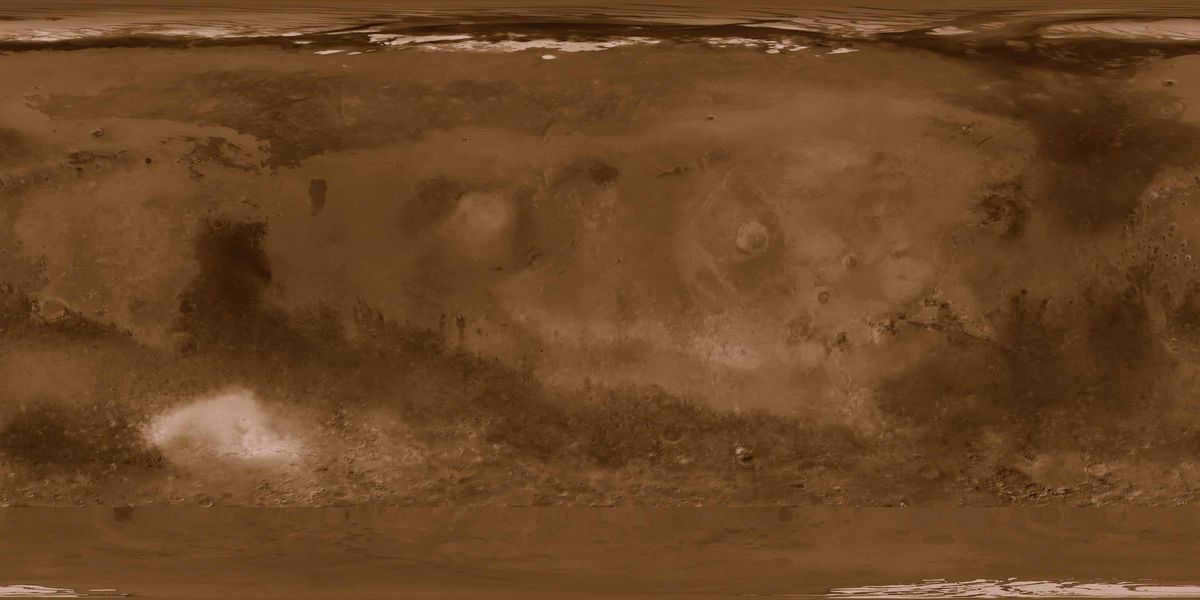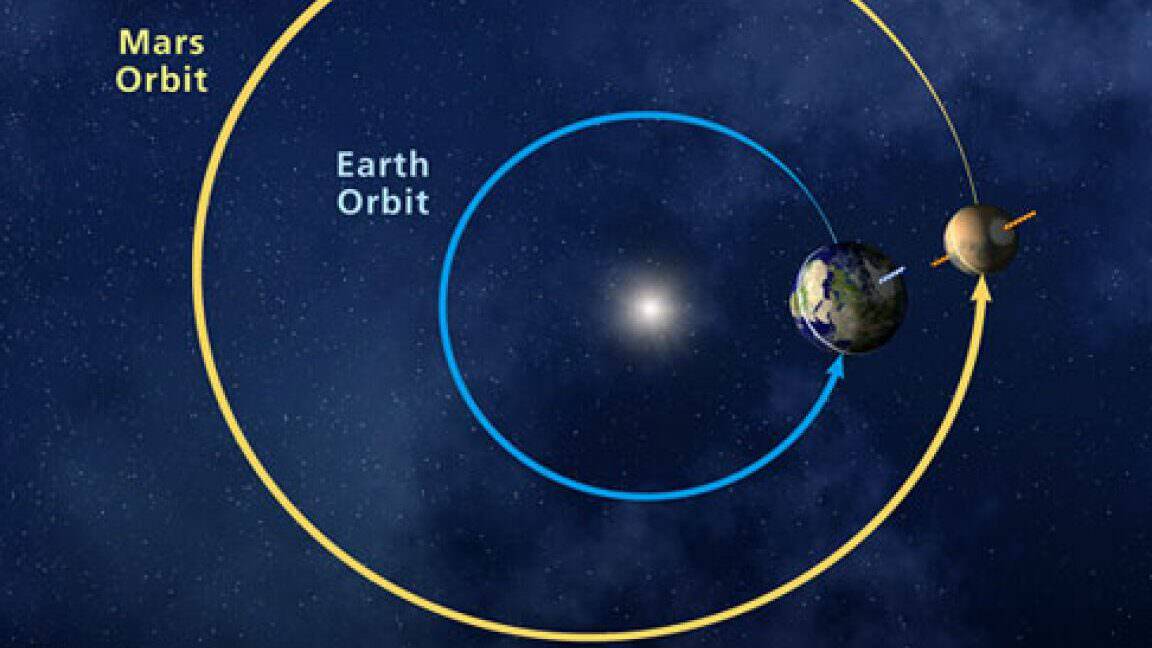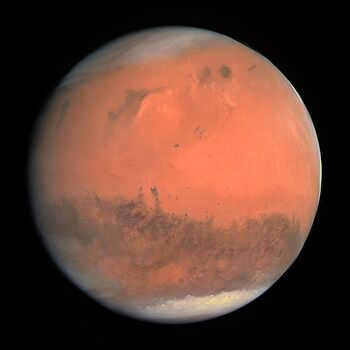
Mars, the fourth planet from the Sun, bears a striking resemblance to Earth. It is also known as the Red Planet, a name derived from its distinct red hue which is a result of iron oxide. The planet was named after the Roman god of war, owing to its fiery appearance. As it periodically comes closer to Earth, Mars often becomes a prominent feature in the night sky.
Its regular appearances have resulted in Mars being featured in numerous myths and legends, often portraying it as a mysterious and menacing entity.
10 Interesting Facts about the Planet Mars
- Mars, also known as the red planet, comprises only 15% of the Earth’s volume, while 2/3 of our planet is covered with water. The gravity on Mars is only 37% of Earth’s, which means that if you were to jump on Mars, your jump would be three times higher!
- The largest volcano in the solar system, Mount Olympus on Mars, stretches 21 kilometers in height and spans 600 kilometers in diameter. It took billions of years to form, and although it is believed to be dormant, lava flows suggest that the volcano may still be active.
- Over the years, approximately 40 missions have been sent to Mars, including flybys, orbiting probes, and rover landings. Some of the most notable missions include Curiosity (2012), MAVEN (2014), India’s Mangalyan (2014), ExoMars, and InSight, which all arrived in 2016.
- These weather calamities have the potential to persist for months and span the entire globe. The seasons become more extreme due to the highly elongated elliptical orbital path. In the southern hemisphere’s closest point, a brief yet scorching summer ensues, while the northern hemisphere plunges into winter. Then, they trade places.
- Scientists have managed to detect minuscule traces of the Martian atmosphere in the meteorites that have arrived on Earth. These meteorites drifted in space for millions of years before reaching our planet. This has facilitated an initial examination of the planet even before the launch of spacecraft.
- In ancient Greece, the god in charge of military actions was known as Ares. The Romans, who often imitated the Greeks, used the name Mars as their equivalent. This trend gave the planet a bloody association. For instance, in China, it was called the “fire star” due to the presence of iron oxide.
- Scientists strongly believe that Mars had water in the form of ice deposits for a significant period of time. The initial indications are the dark streaks or spots found on crater walls and rocks. Given the Martian atmosphere, the water would have to be salty in order to prevent freezing and evaporation.
- In the next 20-40 million years, the moon Phobos will approach dangerously close to Mars and eventually be torn apart by the planet’s gravity. The resulting fragments will form a ring around Mars, which could last for up to a hundred million years.
With an equatorial radius of 3396 km and a polar radius of 3376 km (0.53 times the radius of Earth), we are presented with a celestial body that is literally half the size of our own planet. However, despite its smaller size, it still possesses a substantial mass of 6.4185 x 10^23 kg (0.151 times that of Earth). Another similarity it shares with Earth is its axial inclination, which is measured at 25.19°. This means that, like our planet, it also experiences seasonality.
When it comes to its orbit, this planet reaches its maximum distance from its star (aphelion) at 249.2 million km, while its closest approach (perihelion) is at 206.7 million km. As a result, it takes this planet approximately 1.88 years to complete one full orbit around its star.
Composition and Surface of the Planet Mars
Mars has a density value of 3.93 g/cm 3, which is lower than that of Earth and accounts for only 15% of our volume. As previously mentioned, the red color of Mars is a result of the presence of iron oxide, or rust. However, it also contains other minerals, giving it various colors such as brown, gold, and green.
Mars is classified as an Earth-type planet, meaning it contains high levels of minerals that include oxygen, silicon, and metals. The soil on Mars is slightly alkaline and contains magnesium, potassium, sodium, and chlorine.
Due to these conditions, the surface of Mars is unable to support water. However, there is a thin atmospheric layer that allows ice to persist in the polar regions, which cover a significant area. There is also a hypothesis suggesting the presence of underground water at mid-latitudes on Mars.
Mars possesses a dense core made of metal, accompanied by a mantle composed of silicate. The core is primarily composed of iron sulfide and contains a higher concentration of light elements compared to Earth’s core. The crust extends to a depth of 50-125 km.
The core spans a range of 1700-1850 km and is composed of iron, nickel, and approximately 16-17% sulfur. Due to its smaller size and mass, Mars has a gravitational pull that is only 37.6% as strong as Earth’s. This means that objects on the Martian surface experience a gravitational acceleration of 3.711 m/s^2.
It is important to note the striking similarity of the Martian landscape to that of a desert. The surface is characterized by a dusty and arid environment, featuring mountain ranges, plains, and the largest sand dunes in the entire solar system. Additionally, Mars boasts the tallest mountain, Olympus Mons, and the deepest canyon, Mariner Valley.
There are numerous crater formations visible in the images, which have been preserved thanks to the slow erosion process. Hellas Planitia is the planet’s largest crater, measuring 2,300 km in width and 9 km in depth.
The planet features canyons and channels that may have once served as waterways. Some of these stretch as far as 2000 kilometers in length and 100 kilometers in width.
Mars’ Moons
Mars has two satellites, Phobos and Deimos, that orbit in close proximity. Discovered in 1877 by Asaph Hall, these moons were named after characters from Greek mythology, the sons of Ares, the god of war. Phobos, meaning fear, has a diameter of 22 km and orbits at a distance of 9234.42 – 9517.58 km. It completes one orbit in approximately 7 hours, a time that is gradually decreasing. Scientists predict that in 10-50 million years, Phobos will either collide with Mars or be torn apart by the planet’s gravitational forces, forming a ring structure.
Deimos, meaning terror, has a diameter of 12 km and orbits at a distance of 23455.5 – 23470.9 km. It takes approximately 1.26 days to complete one orbit around Mars. There is also a possibility that Mars has additional moons with a width of 50-100 meters, and a dust ring may form between the two larger moons.
There is a belief that the moons were once regular asteroids that became trapped by the gravitational pull of the planet. However, their circular orbits are not typical for captured objects. Another possibility is that they formed from material that was torn away from the planet during its creation, but in that case, their composition would have to be similar to that of a planet. It is also possible that a violent impact event occurred, similar to the one that formed our Moon.
The characteristics of the atmosphere and temperature on Mars
Mars, also known as the Red Planet, possesses a relatively thin atmosphere composed mainly of carbon dioxide (96%), along with smaller amounts of argon (1.93%), nitrogen (1.89%), and traces of oxygen and water. The atmosphere is also filled with fine dust particles, measuring around 1.5 micrometers in size. The atmospheric pressure ranges between 0.4 and 0.87 kPa.
Due to its distance from the sun and the thinness of its atmosphere, Mars experiences low temperatures. In winter, the temperatures can drop as low as -46°C to -143°C, while in summer, they can reach up to 35°C at the poles and during midday at the equatorial line.
Mars is known for its active dust storms, which can resemble mini-tornadoes. These storms are formed through the process of solar heating, where warmer air currents rise and create storms that can extend for thousands of kilometers.
Research indicates that the Earth has the ability to produce up to 270 tons of methane every year. This methane then rises to the atmosphere and remains there for a period of 0.6 to 4 years before completely breaking down. The mere presence of even a small amount of methane suggests that there is a hidden source of this gas on the planet.
Some possible explanations for this methane include volcanic activity, cometary impacts, or the presence of microorganisms beneath the planet’s surface. Methane can also be produced through a non-biological process known as serpentinization, which involves water, carbon dioxide, and the mineral olivine.
In 2012, the Curiosity rover conducted several methane measurements. The first analysis showed the presence of a certain amount of methane in the atmosphere, while the second analysis showed no methane at all. However, in 2014, the rover detected a spike in methane levels that was ten times higher than normal, indicating a localized emission.
The satellites also detected the presence of ammonia, although its decomposition time is much shorter. Volcanic activity is a potential source.
Exploring the History of Mars
Humans have been observing their red neighbor for centuries, as the planet can be seen without the need for instruments. The first documented observations were made in ancient Egypt in 1534 B.C., where they were already aware of the retrograde motion of Mars. However, they viewed Mars as a peculiar star with different movement compared to the others.
Even before the Neo-Babylonian Empire (539 BC), regular records of planetary positions were kept. People documented changes in movement, variations in brightness, and even attempted to predict their future paths.
During occultation in the 4th century BC, Aristotle observed that Mars was hidden behind a satellite of Earth, suggesting that the planet was farther away than the Moon.
In an attempt to understand planetary motion, Ptolemy constructed a model of the entire universe. He proposed that there were spheres within the planets that caused retrograde motion. It is known that the ancient Chinese were also aware of the planet’s existence in the 4th century BC. Indian explorers estimated its diameter in the 5th century BC.
Ptolemy’s model presented numerous challenges, but it remained the prevailing one until the 16th century when Copernicus introduced his heliocentric system with the Sun at the center. Galileo Galilei’s observations further supported Copernicus’ ideas. These developments facilitated the calculation of Mars’ daily parallax and its distance from Earth.
Giovanni Cassini made the initial measurements in 1672, although his equipment was not very powerful. Parallax was utilized by Tycho Brahe in the 17th century, and Johannes Kepler later corrected it. Christiaan Huygens presented the first map of Mars.
In the 19th century, advancements in instrument resolution allowed for the examination of surface features. As a result, Giovanni Schiaparelli created the first comprehensive map of the Red Planet in 1877. This map also depicted canals, which were later recognized as being simply an optical illusion.
Percival Lowell was inspired by the map to construct an observatory equipped with two highly advanced telescopes (30 and 45 cm in diameter). He authored numerous articles and books discussing Mars, attributing thoughts of Martians to the existence of canals and seasonal changes such as the shrinking polar caps. The subject remained a topic of study even in the 1960s, with ongoing research being conducted.
Exploring the Red Planet [ ]
Missions to Mars commenced in the late 20th century, utilizing space probes. These scientific instruments facilitated our discovery of this extraterrestrial realm, enhancing our knowledge of celestial bodies. Although we have yet to encounter extraterrestrial beings, it is plausible that life may have once thrived there.
Active exploration of Mars began in the 1960s. The USSR launched 9 unmanned probes, unfortunately, none successfully reached the Martian surface. In 1964, NASA’s Mariner 3 and 4 were launched. While the former mission was unsuccessful, the latter spacecraft reached Mars after a 7-month journey.
Mariner 4 successfully captured and transmitted the first high-resolution images of the alien world, along with valuable data regarding atmospheric pressure, the absence of a magnetic field, and the presence of a radiation belt. In 1969, Mariner 6 and 7 also arrived at the enigmatic planet.
In 1971, the United States launched Mariner 8 and 9 into space. Unfortunately, Mariner 8 fell into the waters of the Atlantic Ocean, but Mariner 9 successfully entered orbit around Mars. Along with Mars 2 and 3, these spacecraft experienced a Martian storm and ultimately crashed onto the planet’s surface. After the storm cleared, Mariner 9 captured several images that suggested the presence of liquid water on Mars in the past.
In 1973, the USSR launched four additional landers to Mars. Unfortunately, only Mars-7 failed to deliver useful information. However, Mars-5 proved to be the most valuable, transmitting back 60 images. The United States’ Viking mission was then launched in 1975, consisting of two orbiters and two landers. These spacecraft were designed to collect biosignals and study various aspects of Mars, including seismic activity, weather patterns, and magnetic properties.
Viking’s examination revealed evidence of past water on Mars, as evidenced by the presence of massive floods that carved deep valleys and eroded rock depressions. The Red Planet remained a mystery until the 1990s, when the Mars Pathfinder mission was launched, consisting of a spacecraft and probe. The mission successfully landed in 1987 and tested a wide range of advanced technologies.
In 1999, the Mars Global Surveyor arrived, entering a nearly polar orbit around Mars. Over the course of nearly two years, it extensively studied the planet’s surface, capturing images of gullies and debris streams. The surveyor’s sensors also detected that the planet’s magnetic field is not solely generated in its core, but also partly in its crustal regions. Additionally, the surveyor was able to generate the first 3D views of Mars’ polar cap. Unfortunately, communication with the surveyor was lost in 2006.
The Mars Odyssey spacecraft arrived in 2001 and utilized spectrometers to search for signs of life on Mars. The following year, in 2002, it made a significant discovery of large reserves of hydrogen. In 2003, the Mars Express mission arrived with a probe called Beagle 2, which successfully entered the Martian atmosphere and confirmed the presence of water and carbon dioxide ice at the south pole.
Also in 2003, the well-known Spirit and Opportunity rovers safely landed on Mars and conducted extensive studies of the planet’s rocks and soil. In 2006, the Mars Reconnaissance Orbiter (MRO) reached orbit and its instruments were specifically designed to search for water, ice, and minerals both on and beneath the Martian surface.
The MRO mission carries out daily observations of Martian weather and surface features to identify the most suitable landing sites for future missions. In 2012, the Curiosity rover successfully landed in Gale Crater and its sophisticated instruments play a crucial role in uncovering the planet’s past. Furthermore, in 2014, the MAVEN spacecraft began exploring the Martian atmosphere, while the Mangalyan mission from India’s ISRO also arrived that same year.
In 2016, a comprehensive examination of the internal structure and early geological development commenced. Roscosmos has scheduled its spacecraft to be launched in 2018, while the United Arab Emirates will be joining the mission in 2020.
The public and private space agencies are fully committed to realizing crewed expeditions in the future. NASA is aiming to dispatch the inaugural team of Martian astronauts by the 2030s.
In 2010, Barack Obama emphasized the importance of making Mars a primary objective. The European Space Agency (ESA) has plans to send human beings between 2030 and 2035. Additionally, there are a couple of non-profit organizations that are actively pursuing small-scale missions with crews consisting of up to four individuals. These organizations are receiving funding from sponsors who envision transforming the journey into a live broadcast.
Ilon Musk, the CEO of SpaceX, has embarked on a global mission. He has already achieved a remarkable breakthrough – a reusable launch system that saves both time and money. The inaugural Mars expedition is set to take place in 2022, marking the beginning of potential colonization.
Mars is widely regarded as the most extensively explored extraterrestrial planet in our solar system. Through the use of rovers and probes, scientists continue to uncover new insights about its unique features. Notably, they have confirmed striking similarities between Earth and the Red Planet, including polar glaciers, seasonal variations, an atmospheric layer, and the presence of flowing water. Furthermore, there is evidence suggesting the possibility of past life on Mars. This incessant exploration of Mars only reinforces the belief that it will likely be the first planet to be colonized.

The celestial element has forever possessed a captivating and mesmerizing allure, drawing the gaze of curious intellects yearning to uncover its mysteries. Among the roster of celestial bodies visible in the nocturnal sky, one can spot Mars, which presents itself to the observant beholder as a diminutive crimson orb. It emits a steady radiance impervious to fleeting changes, such as flickers and flares.

For over 3.5 thousand years before our era, astronomers from ancient Egypt and Babylonia dedicated themselves to the study of Mars, leaving behind highly credible information about the planet.
If we begin counting from the celestial body, then Mars, which is the fourth planet orbiting it, belongs to the group of planets known as the Earth group. This group also includes Mercury, Venus, and Earth itself. Unlike the giant and dwarf planets, the Earth group is characterized by its high density and uniform internal structure.
Out of all the planets in the Solar System, Mars is only the seventh largest. During their closest approach, the distance from Earth to Mars can reach up to 55.76 million km. Due to this proximity and various other factors (including its potential for future colonization), Mars is currently the most extensively studied planet in our solar system, excluding, of course, our own planet Earth.
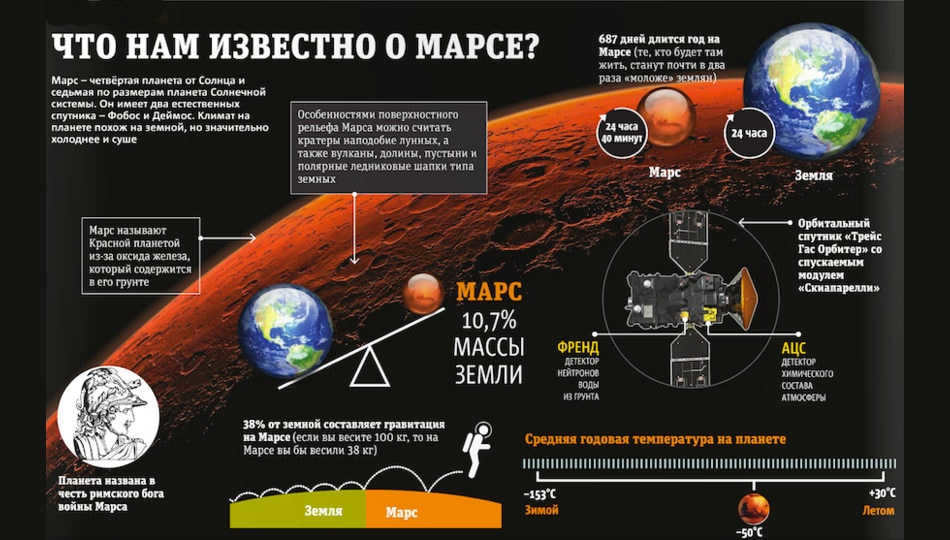
Origins, formation, and development
Based on the widely accepted cosmogonic theory regarding the creation of the planets in the solar system (which is continuously updated with new hypotheses and scientific research findings), Mars came into existence around 4.6 billion years ago. The original nebula, which was a gas and dust cloud, gradually transformed into a disk due to internal gravitational forces. This disk then formed planetesimals, which are celestial bodies capable of increasing in size and mass by attracting smaller cosmic formations.
Mars, unlike Earth, existed in a distinct set of conditions that were much more sparse in terms of the existence of primordial matter. This unique circumstance contributed to its significantly smaller size. It is believed that around 4.2 billion years ago, Mars’ core underwent a transition into a solid state, and approximately 4.1 billion years ago, the formation process concluded, resulting in the planet’s current state as a member of the terrestrial group alongside Earth.


There is a theory suggesting that in the remote past, Mars may have supported life due to the presence of water and clay, providing favorable conditions for organisms. However, this hypothesis lacks direct evidence and proof, and further research is needed to confirm it. Additionally, Mars experienced active volcanic activity, which contributed minerals and water to its surface.
Presently, Mars is a lifeless and cold planet, characterized by a series of extinct volcanoes and numerous craters. Its geological history can be divided into four distinct evolutionary periods that have shaped its current surface state.

- The Prednoic era, occurring 4.6-4.5 billion years ago, led to the creation of varying elevations with a three-kilometer difference and resulted in the formation of the Hellas Basin, ranking third among the largest craters in the entire solar system.
- The Noah era, which took place 4.1-3.7 billion years ago, was a period of significant expansion of water bodies, asteroid and meteorite impacts, and active volcanic activity. The most notable feature of this geological epoch is Tharsis – the region where the largest volcanoes in our solar system, stretching 5 thousand kilometers wide, are concentrated.
- The Hesperian period, which occurred 3.7-3 billion years ago, witnessed the planet’s surface being engulfed in lava plains and the drying up of water streams, leaving behind channels. It is during this era that Olympus, the largest volcano in the solar system, emerges.
- The Amazonian period, which spans from 3 billion years ago to the present, marks the end of volcanic activity and erosion processes on Mars. The planet becomes covered with thick ice caps.
Physical and chemical characteristics
Mars, the seventh largest planet in the solar system, is considerably smaller in size compared to Earth. In terms of its physical attributes such as diameter and mass, it is only surpassed by Mercury.
Physical attributes: A comparison between Mars and Earth
The mass of Mars is 6.4171-10 23 kg, which is approximately 0.107 times the mass of Earth. In other words, Mars’s mass is slightly more than one hundredth of Earth’s mass.
The volume of Mars is 1.6318-10 11 km 3 , which is equivalent to 0.151 times the volume of Earth.


The density of Mars is 3.933 g/cm 3 , which is 0.714 lower than that of Earth.
The surface area of Mars is about 1.4437-10 8 km 2 .
Mars rotates at an equatorial speed of 868.22 km/hour.
Martian timekeeping
The average length of a Martian sidereal day is 24 hours, 37 minutes, and 22.633 seconds. However, the length of an average Martian solar day, known as “sols” by astronomers, is 24 hours, 39 minutes, and 35.24409 seconds, which is 2.7% longer than an Earth day.
A Martian year consists of 668.9 sols or 686.98 Earth solar days. Due to its axial tilt of 25.19°, Mars experiences distinct seasons with significantly longer durations compared to Earth’s seasons. This can be seen in the following diagram:
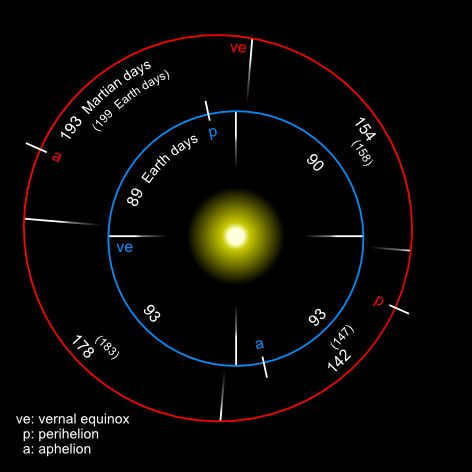
Chemical composition
Mars, like other terrestrial planets, consists of metals, silicates, and various chemical elements in its rock composition. This is a general overview of the composition of Mars. To obtain a more accurate understanding, samples of materials are needed, which are expected to be collected in the near future.
One thing we can say with certainty is that the atmosphere of Mars contains a significant amount of carbon dioxide, and its crust has higher levels of volatile elements such as sulfur and chlorine compared to Earth. The mantle of Mars contains twice as much iron as Earth’s mantle, as well as higher levels of potassium and phosphorus. The core of Mars is also rich in sulfur.
The mantle, a dense layer of material measuring 1240-1880 kilometers in thickness, consists of:
The core, which is relatively solid, is comprised of:
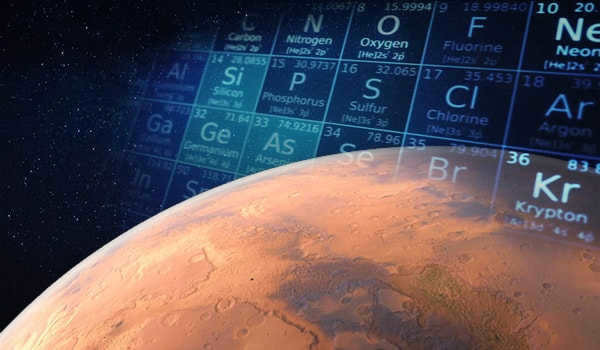
- metal,
- element,
- compound.
Atmosphere and Climate Conditions on Mars
Mars has an atmosphere that is approximately 110 kilometers thick. The composition of the atmosphere includes:
- Carbon dioxide, which accounts for 95.32% of the atmosphere
- Nitrogen, which makes up 2.7%
- Argon, which makes up 1.6%
- Oxygen, which accounts for 0.145%
- There are also other components present.
The average surface level of Mars has a pressure of 6.1 mbar. As a result, the temperatures on Mars can range from -153° C at the poles during winter to up to +20° C at the equator during summer.
The surface of Mars experiences high levels of radiation due to the lack of a magnetosphere and the thinness of the atmosphere. This means that a person present on Mars for just a few days could be exposed to the same amount of radiation that they would receive on Earth in a whole year.
In Mars, the northern hemisphere experiences cool summers and mild winters, while the southern hemisphere has cold winters and warmer summers, defining the seasonal changes on the planet.

Characteristics of the planet’s surface
Mars is externally characterized by light and dark areas. Researchers refer to the larger areas, covering two-thirds of the surface, as continents, while the smaller areas, covering one-third, are known as seas. In addition, Mars features polar caps at the North and South poles, with thicknesses ranging from 1 meter to 3.7 kilometers.
The disappearance of the famous Martian canals, which occurred by the beginning of the 3rd millennium, is likely attributed to tectonic activity. However, there is more concrete evidence supporting the existence of a significant hydrosphere on Mars. This evidence includes the discovery of a river delta, ice deposits, and minerals that can only be formed by the presence of water.
The previous movement of lithospheric plates on Mars has now come to a halt. There is only minimal tectonic and seismic activity, with the latter resulting in only small-scale tremors on the planet.
Internally, Mars is composed of:
- a crust that ranges from 50 to 125 kilometers in thickness,
- a mantle that measures 1,500 kilometers in thickness,
- a core with a diameter of 3,400 kilometers.
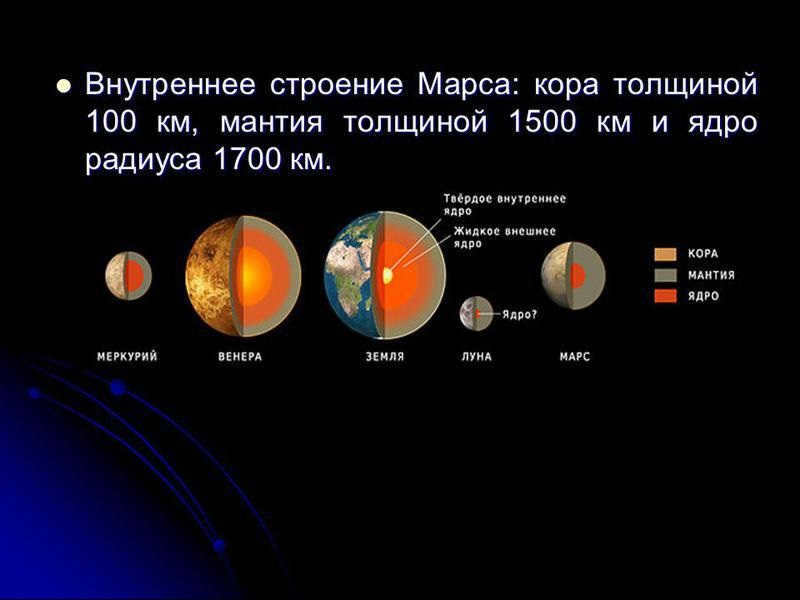
Magnetism
Several years ago, Soviet autonomous interplanetary stations conducted various studies and concluded that there is a lack of a self-generation mechanism within Mars, resulting in the absence of a significant magnetic field on the planet.
Geology
The field of Martian geology is presently quite comprehended, despite the potential for novel revelations that could fundamentally alter our comprehension of this celestial body. The composition of the planet Mars has been elucidated earlier, and here is the depiction of its geologic map as of July 14, 2014:

Origin of the planet’s name
If you are familiar with ancient Greek and Roman mythology, it is not difficult to guess the source of the name Mars. It is derived from the Roman god of war, Mars, who symbolizes the planet’s bloody hue. In Greek mythology, Mars is equivalent to Ares, the god of war and one of the twelve Olympian gods. Ares had numerous descendants, including his sons Phobos (fear) and Deimos (terror), whose names were later given to the moons of Mars.
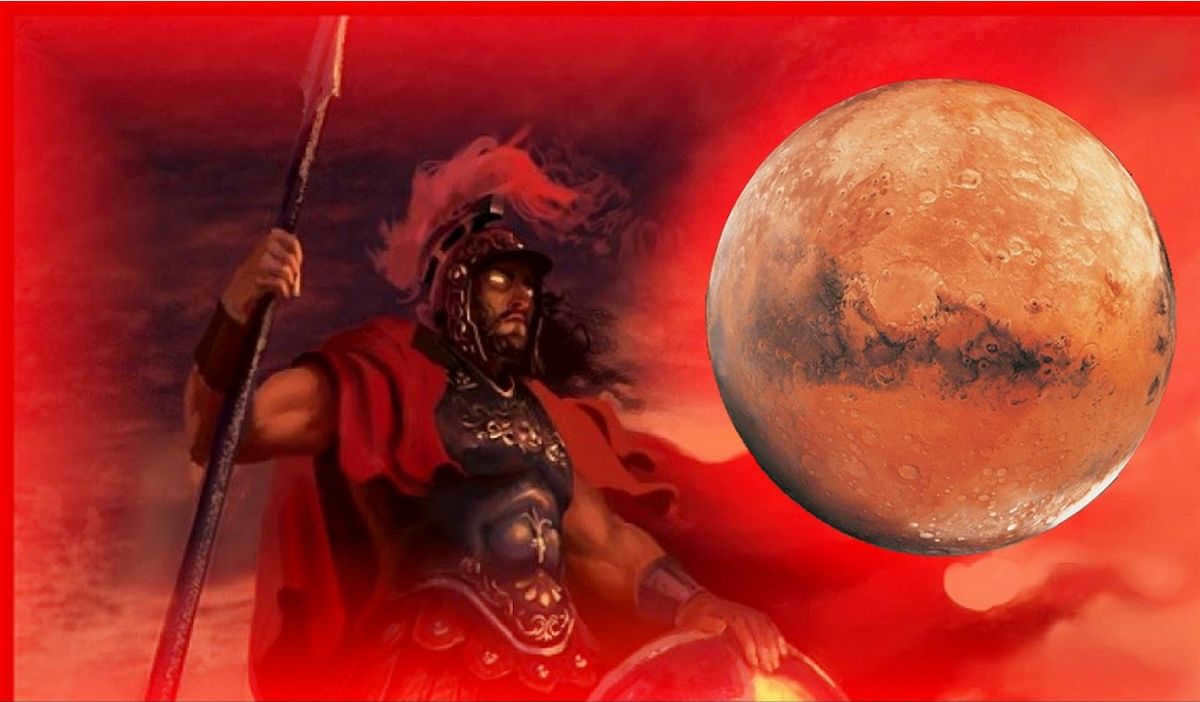
Orbital parameters
Mars, the fourth planet in our solar system, orbits its star in a complex elliptical path. The duration of Mars’ orbit around the sun is as follows:
- The sideric orbital period, which is the time it takes for Mars to complete one orbit around the sun when viewed from space, is 686.98 Earth days.
- The synodic period of revolution, which is the time it takes for Mars to appear in the same position relative to the Earth, is 779.94 Earth days.
The eccentricity of Mars’ orbit, which measures the “compression” of the orbit, is much greater than that of Earth and is equal to 0.933941. The distance from Mars to the Sun varies between 206.7 and 249.2 million kilometers. The average speed of Mars’ orbit around the Sun is 24.13 km. Additionally, Mars approaches the Earth at a distance of 55.76 million kilometers and then moves away from it at a distance of 401 million kilometers.
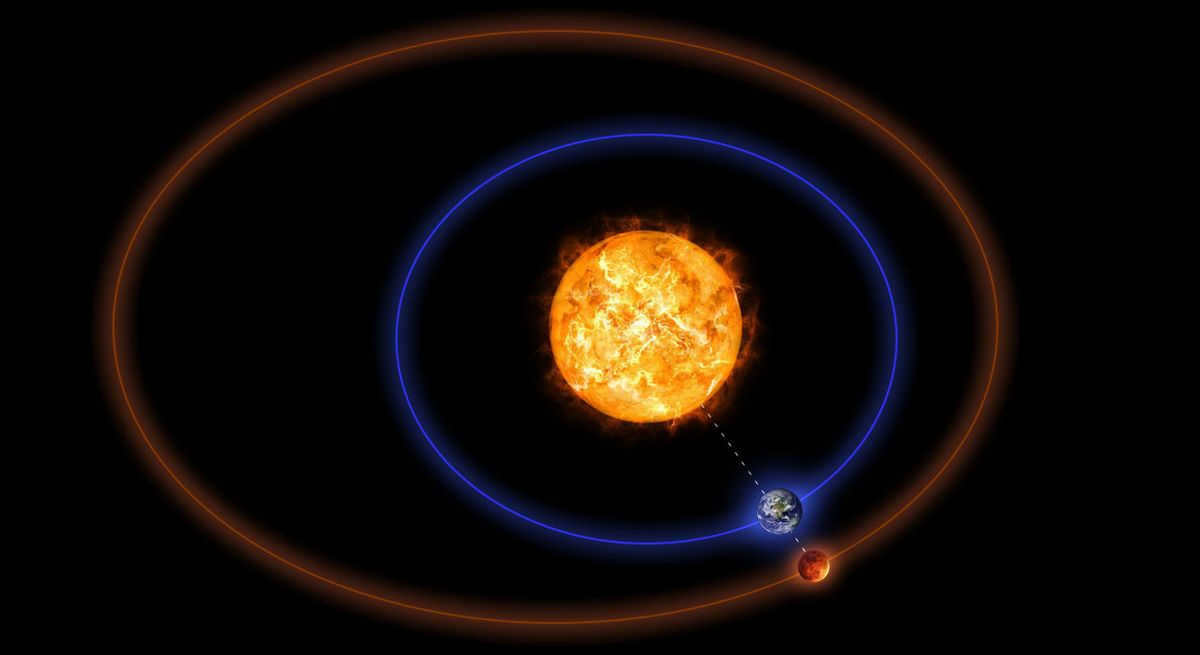
Photos of Mars
The images of the surface of other planets and celestial bodies captured by modern science, which has successfully ventured into interplanetary space with its advanced stations, are truly captivating. These visuals ignite a sense of curiosity among researchers and stimulate the quest for signs of extraterrestrial civilizations, prompting further exploration plans.
Our ancestors from not too long ago were always curious: what is the true appearance of Mars? It can be described in any manner you prefer, considering that it is an uninhabited rocky wasteland that hides numerous enigmas. It is adorned with an immense amount of craters and volcanoes, and adorned with a noteworthy assortment of rocks, plains, and lowlands. Additionally, it shimmers with a magnificent array of colors, showcasing the captivating artistry of the natural forces responsible for its creation.

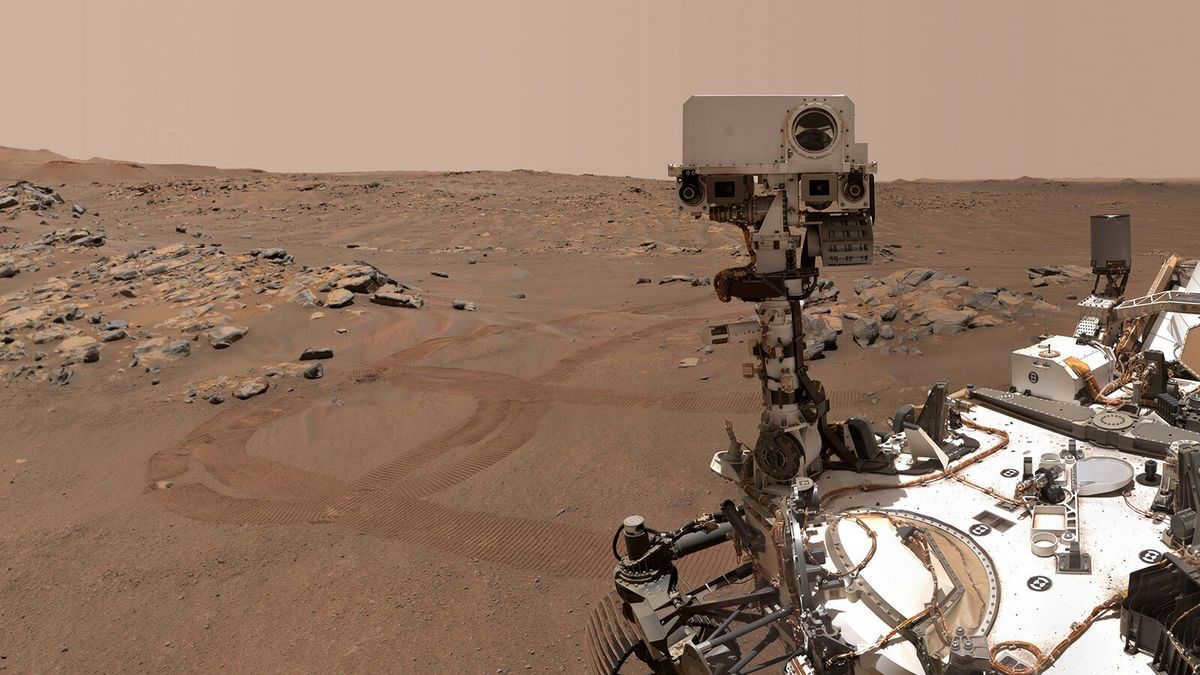
Astronomy for Kids: Explaining the Wonders of Space to Young Explorers
As we strive to comprehend the mysteries of the universe, it is important not to overlook the youngest members of our society who are just beginning their journey of discovery. Parents and educators can play a crucial role in nurturing their curiosity by introducing them to the mesmerizing wonders of the night sky. By unfolding a vibrant celestial map, children can marvel at the vastness of the cosmos and focus their attention on the awe-inspiring realm of our very own solar system.
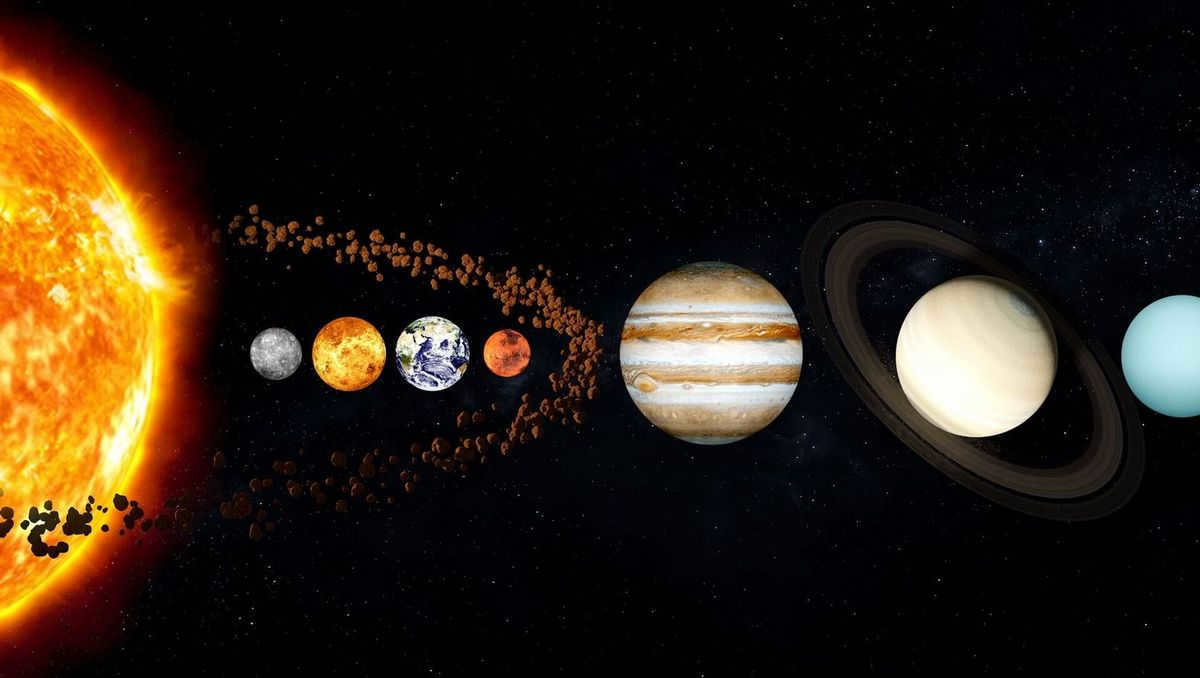
Undoubtedly, it is essential to acquaint them with its composition. Educate them on the Sun and the celestial entities orbiting around it. Without neglecting to reference the Earth, provide intricate information about its nearest counterparts and even highlight the planetary sequence preceding Mars and succeeding it.
When providing information to your students about the fourth planet in our solar system, it is crucial to highlight its size and the length of a Martian year. Additionally, it is important to compare the duration of Mars’ rotation on its axis to that of Earth, so that they can understand the difference.
Furthermore, it is essential to draw attention to the unique features of Mars, such as its volcanoes, craters, and hollows. By subtly hinting at the absence of water, vegetation, and a harsh, lifeless climate, we can instill a love and appreciation for the diverse environments found on Earth. This can also stimulate their curiosity and desire to explore the unknown.
Martian Moons – Explained for Kids
During these educational sessions, it would be fitting to discuss the moons of the planets in our solar system, including Earth’s moon. And, while acknowledging the ancient myths that inspired our ancestors, we can explain that Phobos and Deimos are the offspring (satellites) of the god Mars and the planet Mars. It is worth mentioning Jonathan Swift, the author of the renowned book “Gulliver’s Travels,” who was the first to predict that this planet has two moons.
Exploration and Missions to Mars
What could be more captivating for the younger generation than tales of space travel and the conquest of distant extraterrestrial worlds! Especially when we’re discussing the nearest planet to us, a human mission to which may occur in the very near future.
The groundwork for this endeavor was first laid by the internationally acclaimed scientist, Galileo Galilei, and the initial spacecraft were dispatched by the USSR and the USA. Subsequently, the European Space Agency, India, Russia (which inherited the space advancements of the USSR), the United Arab Emirates, and China have all joined in these efforts.
As a result, we now possess the most comprehensive data about Mars, an enormous collection of planet images, and five working apparatuses on its surface: rovers, landing vehicles, and rovers.
What is the reason behind Mars’ red color?
The inquiry, which evoked a sense of mystical dread in ancient times – connecting the planet to the realm of war and its associated deities – has gradually been elucidated by scientific reasoning.
The crux of the matter lies in the fact that Mars’ surface is coated with a layer of dust ranging from a few millimeters to 2 meters in thickness (Farsida Highlands), containing iron oxides. This is what lends the planet its reddish tint.

Exploring Mars: A New Frontier for Tourists
It won’t be long before the first space explorers have the opportunity to witness the wonders of the red planet with their own eyes. The journey from Mars to Earth can be completed in 39, 162, or 289 days, depending on the chosen flight path. The round trip is estimated to take 450 Earth days, equivalent to 1.2 years.
- The no longer active volcano Olympus.
- The deep canyons of the Mariner Valleys.
- The intricate Labyrinth of Night.
- The impressive Elysium complex.
- Unusual morphological structures.
- The visible marks of massive meteorite impacts.
- Rocks resembling vertical ice pillars.
And many other fascinating attractions that will undoubtedly capture the attention and interest of visitors from other planets, who will be provided with comfortable transportation options, equipped with all the necessary observation and videography tools.
Mount Olympus
Situated amidst a cluster of adjacent peaks – and indeed, resembling them – dormant volcanoes, Mount Olympus on Mars, found within a vast basin plunging two kilometers deep in the Farsida region, stands out as the most extraordinary feature in the entire Solar System. What sets it apart is its colossal dimensions, unparalleled within our celestial sphere:
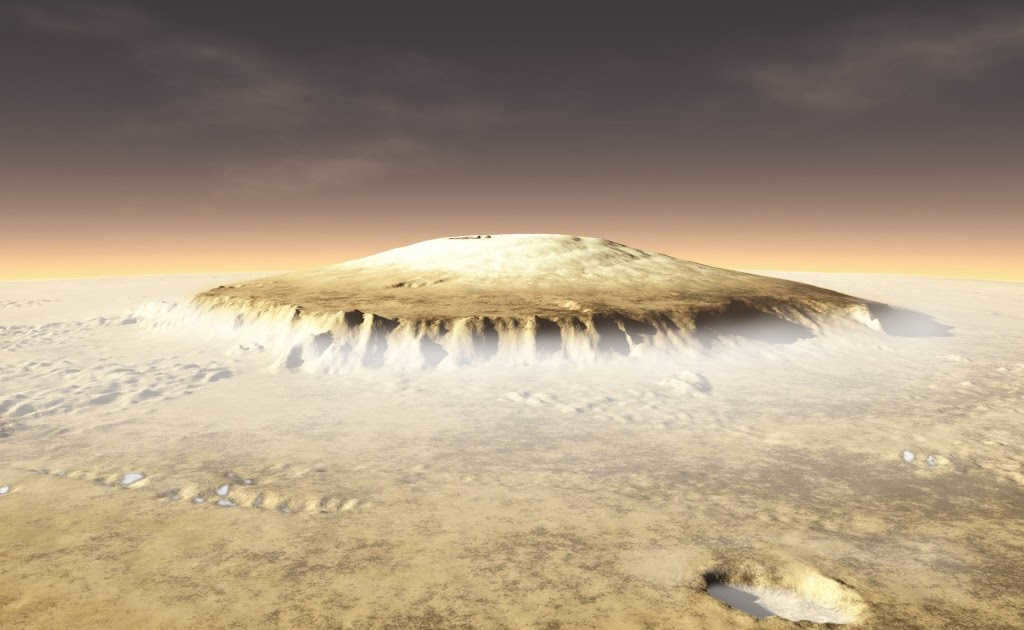
- The base of Mount Olympus stands at an impressive height of 26 kilometers;
- It has a diameter of approximately 540 kilometers;
- The mountain system known as the Halo of Olympus extends in the form of unique “petals” for a distance of 1 thousand kilometers!
The Mariner valleys: A colossal formation stretching 4500 km in length, with a width of up to 600 km and a depth reaching 11 km. This incredible cluster consists of six distinct regions.
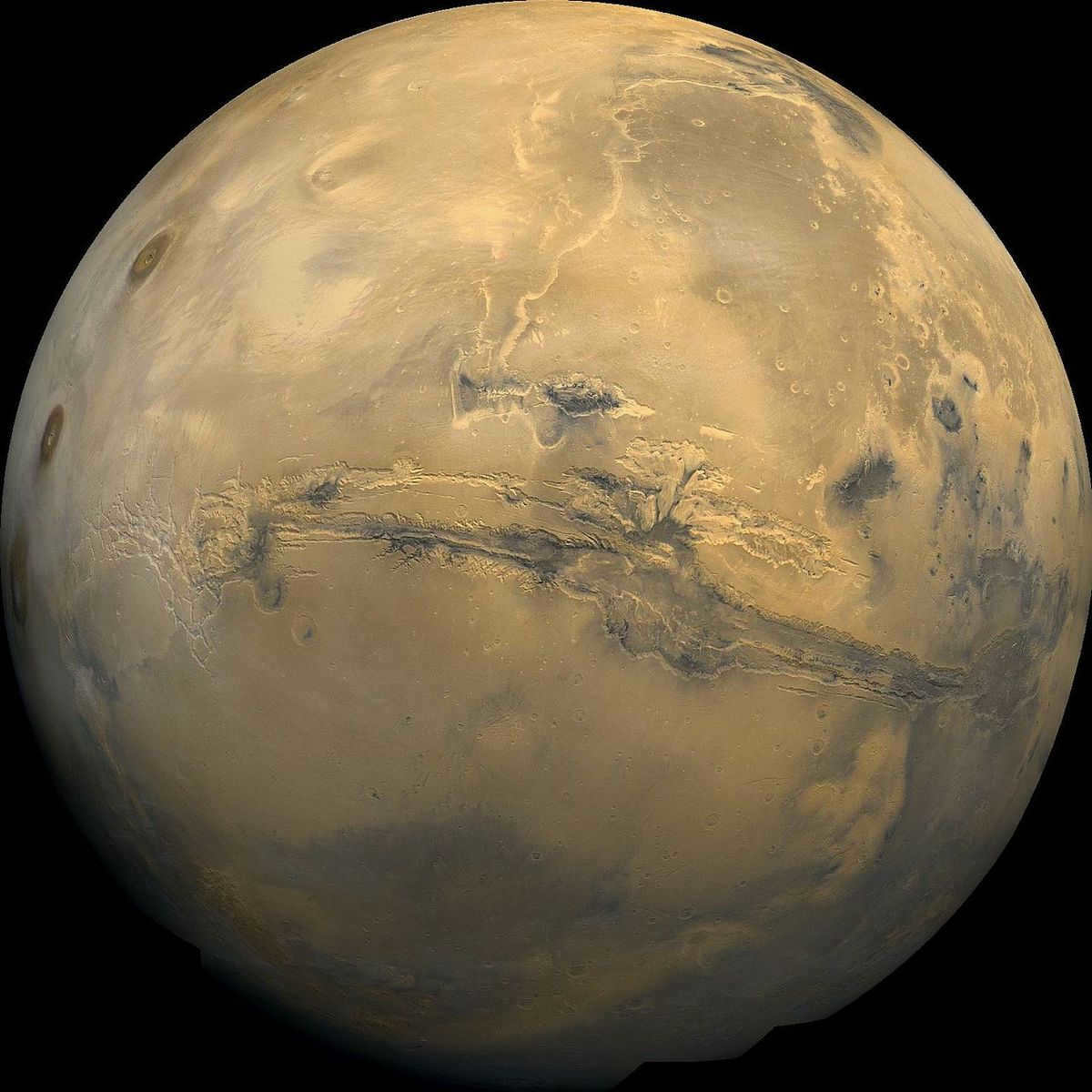
- The Night Maze.
- The ravines of Ganges, Io, Candor and Coprates, Melas, Ophir, Tithon, Eos.
- The Field of Jesus.
Exciting Information and Future Prospects
Without a doubt: Mars is an intriguing planet within our solar system, and it continues to captivate us with its fascinating attributes. It is considered the most promising celestial body for further scientific exploration, potential colonization, and even the ambitious concept of terraforming.
In the past, Mars had liquid water and active volcanic activity. Additionally, it boasts a plentiful supply of essential materials for construction, and its day and night cycle closely resembles that of Earth. There is a possibility that under the influence of sunlight, rudimentary forms of biological life may have emerged, only to succumb to the harsh climate conditions.
Regardless, the red planet is currently a highly sought-after destination for those interested in future colonization efforts. Some notable ventures include:
- The Orion mission by NASA and SSL, scheduled for 2030.
- A joint undertaking by the European Space Agency (ESA) and the Russian space agency Roscosmos.
- A group of entrepreneurs from the Netherlands is currently in the process of organizing a settlement on Mars, with the goal of establishing a permanent colony by 2023.
- Ilon Max, a well-known American entrepreneur, is planning a manned mission to the SpaceX base in 2024, and his statements, projects, and achievements have made him famous.
Undertaking such a task is no easy feat, as it requires immense funding and effort. One example of this can be seen in the following:

Space
An attentive observer gazing up at the starry night sky may catch sight of a small, reddish spherical object. That object is Mars. It captivates with its aura of mystery and unwavering hope – the hope of uncovering the “thread” that will unlock the vast enigmas of the universe.
Planet’s Characteristics
The first recorded observations of this celestial neighbor date back to the time of the Egyptian pharaohs, over one and a half millennia before our era. Ancient astronomers were able to detect Mars’ “retrograde” motion and determine its position in the sky, situated between Earth, the asteroid belt, and Jupiter.
Mars occupies the fourth orbit in our solar system, just after Earth. Here are its key dimensions:
- radius of 3396 kilometers (53% of Earth’s radius);
- The Red Planet has a surface area of 144.37 million square kilometers, accounting for 28.3% of the Earth’s surface.
Mars has a mass of 6.4171×1020 tons, which is equivalent to 10.7% of the Earth’s mass. In terms of size, it ranks seventh among the sun’s satellites.
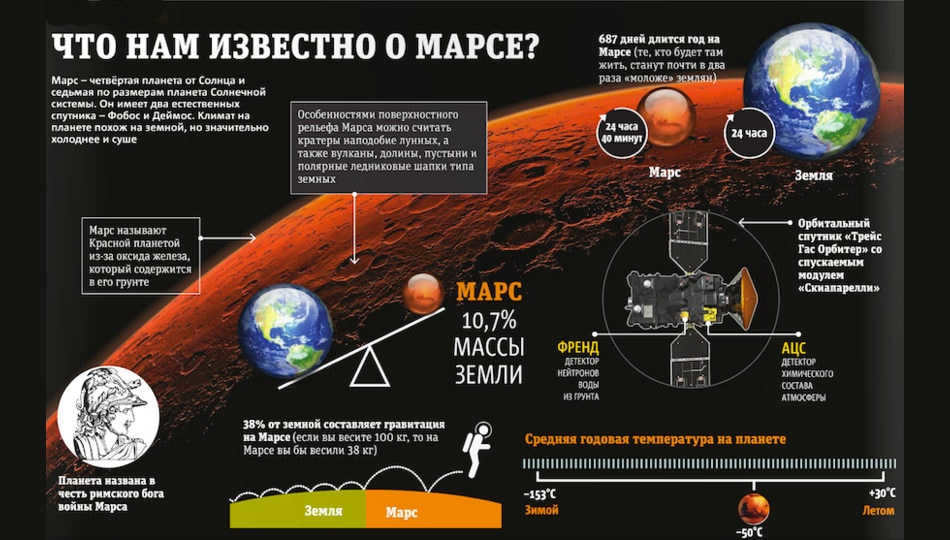
The planet Mars orbits the Sun in an elliptical path with a notable eccentricity of 0.0934. As a result, the distance between the two fluctuates by 42.6 million kilometers during its revolution. This causes the planets to move closer to each other and then farther apart.
A variety of physical characteristics
- The average density of soil on Mars is 3930 kg per cubic meter, which is 28.7% lower than the specific gravity of what is beneath us.
- The temperature on Mars can fluctuate by up to 188° C. In the winter, it can reach as low as -153° C, while in the summer, the surface can warm up to +35° C.
- An object in free fall on Mars will experience an acceleration of 3.711 m/sec per second, which is equivalent to 0.378 g.
- The atmosphere on the planet is highly sparse, and the magnetic field is weak.
- Mars has an axial tilt of 25.2 degrees, resulting in the succession of winter followed by spring, and summer followed by fall.
Organization
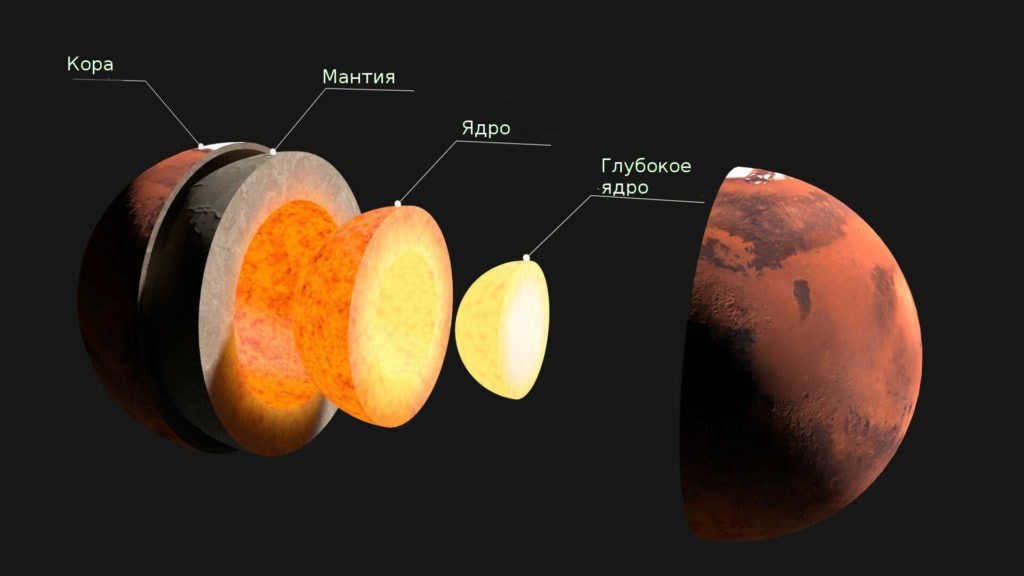
The composition of Mars’s structure follows a conventional pattern.
The arrangement of layers in Mars’s structure is characterized by a significantly higher density at its center compared to the surrounding layers. The crust and mantle, as indicated in the table, are approximately half as dense. The overall density of the planet suggests a rocky composition.

Chemical makeup
- Crust: Silicon accounts for 21% of its composition, followed by iron at 12.7% and sulfur at 3.1%.
- The mantle contains a high concentration of iron sulfide, but the amount of metallic iron is minimal.
- The core primarily consists of iron and sulfur.
Orbit and rotational characteristics
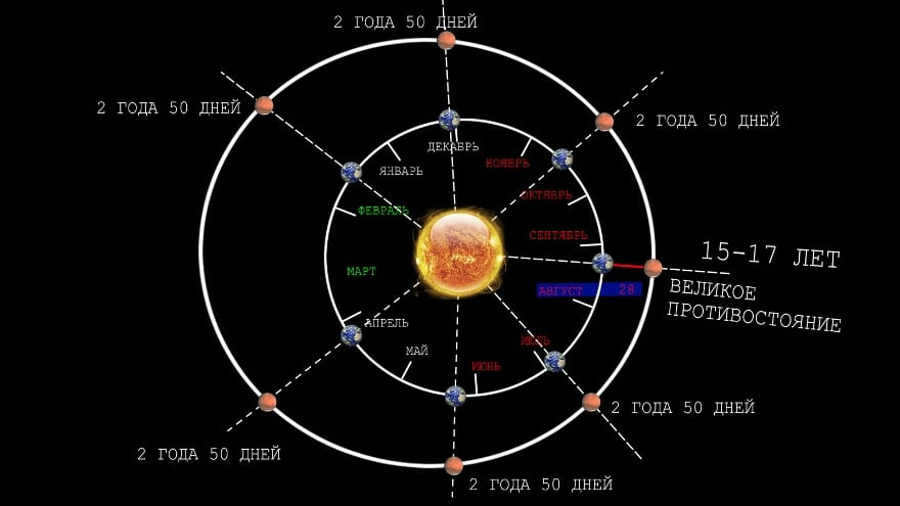
Mars orbits the Sun in an elongated elliptical path, traveling at a speed of 24 km/sec. This means that the distance between Mars and the Sun can range from 206.6 to 249.2 million kilometers. It takes Mars approximately 687 Earth days, or 1.88 years, to complete one orbit. A Martian day, known as a “sol,” is longer than an Earth day by 37.5 to 40 minutes.
The shape of Mars’ orbit is influenced by the gravitational forces of other celestial bodies in its vicinity. Scientists believe that in the past, Mars may have had a more circular orbit, possibly with less eccentricity than Earth’s orbit.

Mars has a tilt of 25.9 to 25.19 degrees, resulting in changing seasons. The duration of these seasons varies, with the warm season (spring and summer) lasting 371 “sols” in the Northern Hemisphere.
Did you know? Mars experiences blizzards at night. Strong winds carry falling snowflakes, creating actual storms.
The Martian Temperature
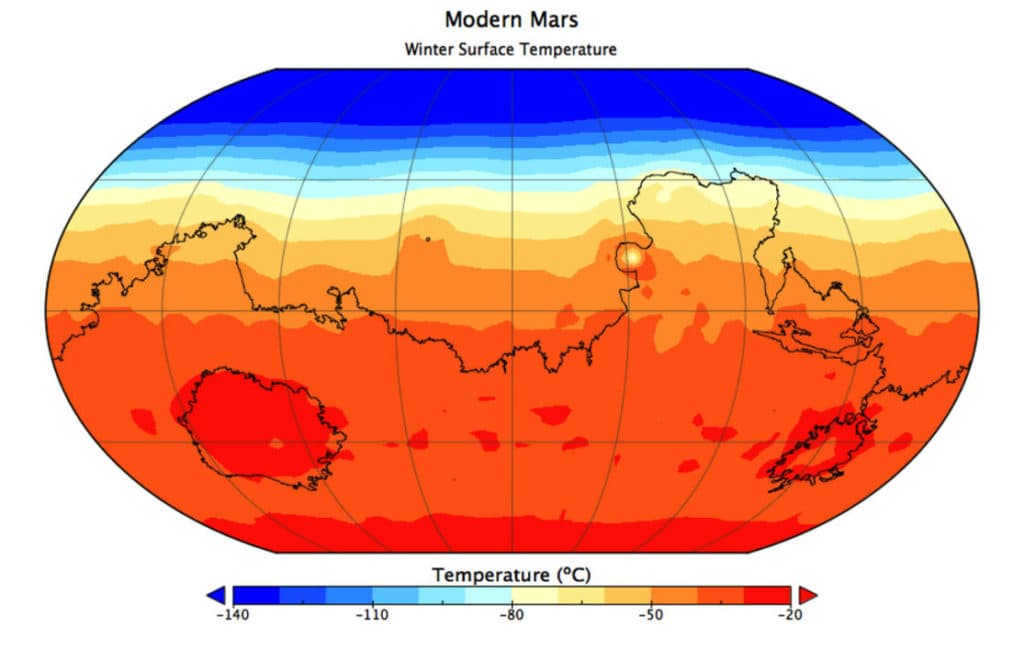
Because of the absence of a substantial atmosphere, the surface of the neighboring planet to Earth at the outer regions of the solar system, and therefore less exposed to heat, experiences extreme cooling. The average yearly temperature ranges from -50° to -60°C. There have been instances of the poles and equator reaching temperatures as high as +35°C. However, this does not alter the overall meteorological landscape.
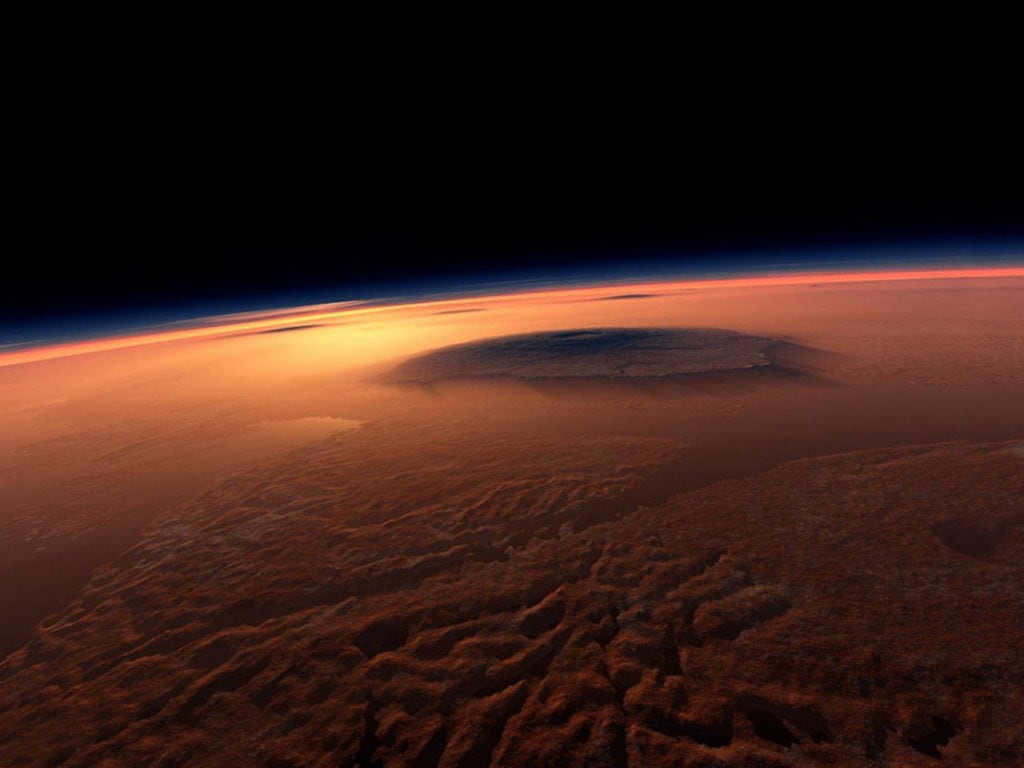
Scientists have extensively examined the atmosphere of our neighboring planet as a potential habitat for human beings. This research has revealed a plethora of intriguing discoveries. However, as is often the case in scientific inquiry, some initial optimistic predictions had to be discarded for specific reasons.
The atmosphere of Mars is incredibly thin, comprising only 1% of the atmospheric pressure found on Earth. To experience Martian atmospheric conditions that are comparable to those on Earth, one would need to ascend to an altitude of 35 kilometers.
Mars’s gaseous envelope consists of 95% carbon dioxide. However, due to its tenuous nature, the planet does not experience the greenhouse effect. Nevertheless, there is water present, albeit not in a liquid state. Vast polar “caps” composed of H2O saturate the atmosphere with water vapor. Scientists are confident that they will discover subterranean “seas” on Mars, possibly even at shallow depths.
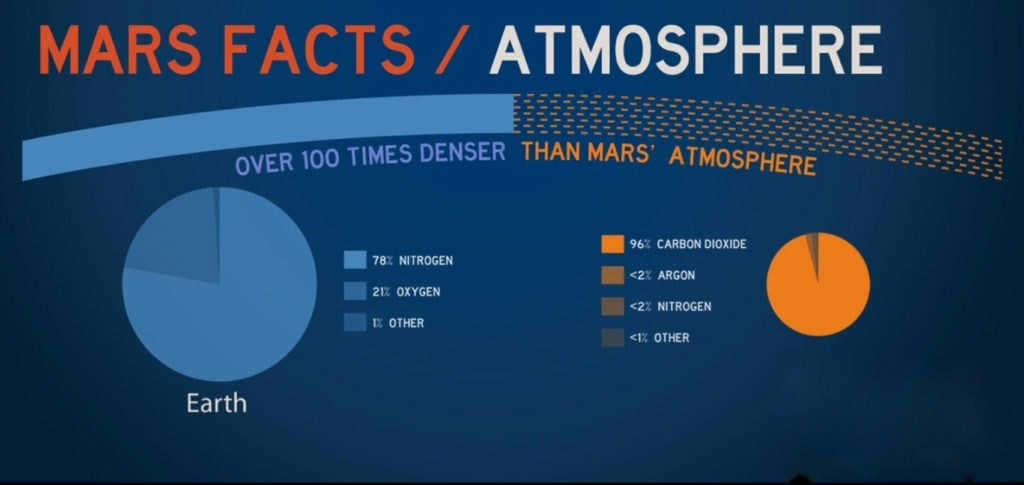

It is intriguing to note that the scanty atmosphere on Mars is responsible for creating surprisingly similar climatic conditions as those found on Earth. The Martian atmosphere experiences gusts of wind, dust storms, fog, and even extreme cold temperatures (occasionally dropping as low as minus one hundred and fifty degrees Celsius).
Leakage of Atmosphere
Until recently, the primary theory regarding the leakage of atmosphere from the surface of Mars was the unverified notion of a cosmic collision. However, new information has emerged. In 2013, the MAVEN interplanetary spacecraft conducted an investigation of the Red Planet. As a result of this study, many discoveries were made.
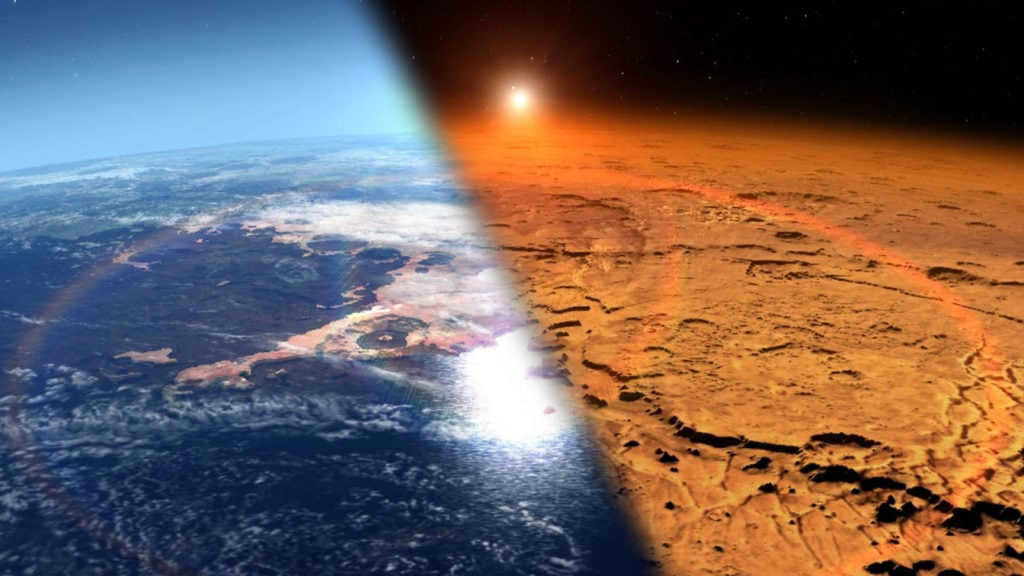
Billions of years ago, the red planet had a warm and moist climate. It featured vast bodies of water that could have potentially supported life forms. Around 4.2 billion years ago, Mars experienced a mysterious event that caused it to lose its magnetic field. As a result, the planet began to lose its atmosphere, with a gradual leakage into space. This process continues to this day, albeit at a much slower rate of 100 grams per second. However, during solar storms, the influence of solar wind streams accelerates the depletion of the gas layer.
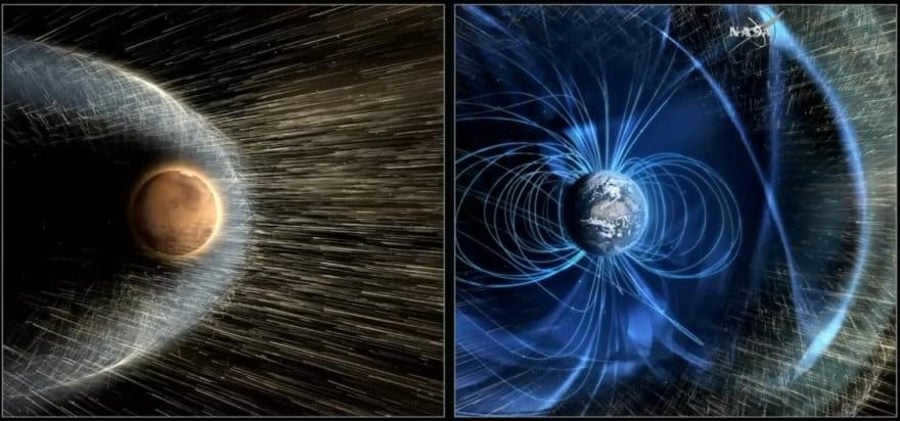

Without any alterations, the atmosphere of Mars will vanish within a few billion years.
Throughout the entire period of observations and practical research of the surface of the Red Planet, a vast history has accumulated. It is worth focusing on its various stages.
The history of observing Mars and the optical illusions
Martian Canals
In the 19th century, significant astronomical observations began. The Italian scientist Giovanni Schiaparelli proposed the existence of canals encircling the planet. This theory gained strong support within the scientific community. A map of Mars was created, featuring hundreds of delicate lines, each with meaningful names.
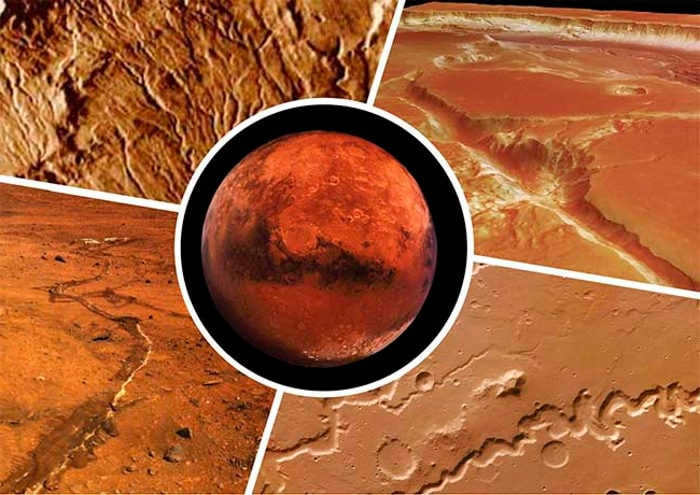
What’s particularly fascinating is that the appearance of these geometric formations was attributed to the ingenuity of extraterrestrial beings. “Resourceful Martians utilize the melted ice from the polar glaciers for their economic endeavors.” Nowadays, this assertion elicits nothing more than a chuckle, but at that time even esteemed scientists held this perspective.

Undoubtedly, there exist formations on the planet next to ours that bear a resemblance to linear structures, albeit with limited visibility through telescopes. This fascinating visual phenomenon, however, was debunked in 1971-1972 when the Mariner 9 spacecraft captured clear images of Mars, revealing that these supposed lines were nothing more than an optical illusion.
The Mars Sphinx: A Startling Discovery
However, a startling revelation emerged with the arrival of a fresh communication. The mere mention of a “Human Face” coupled with the term “Sphinx” ignited the imaginations of countless science fiction enthusiasts and set the stage for intense speculation.
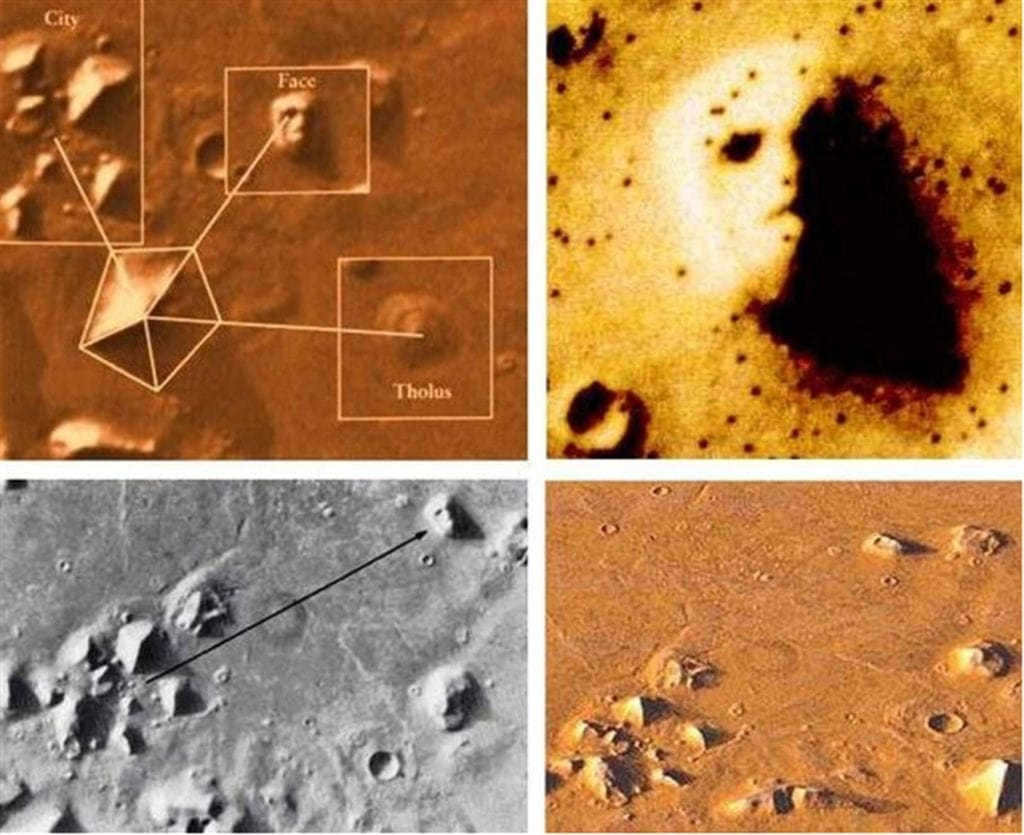
An average heap of stones, captured by the Viking-1 station in 1976. Once again, the photograph has a low optical resolution, but it is further enhanced by the interplay of vibrant colors and the imaginative minds of individuals who are eager to find signs of extraterrestrial intelligence in every corner.
Polar ice caps
One of the similarities between Earth and Mars lies in the presence of icy “continents” in their respective polar regions, indicating comparable physical and climatic processes.
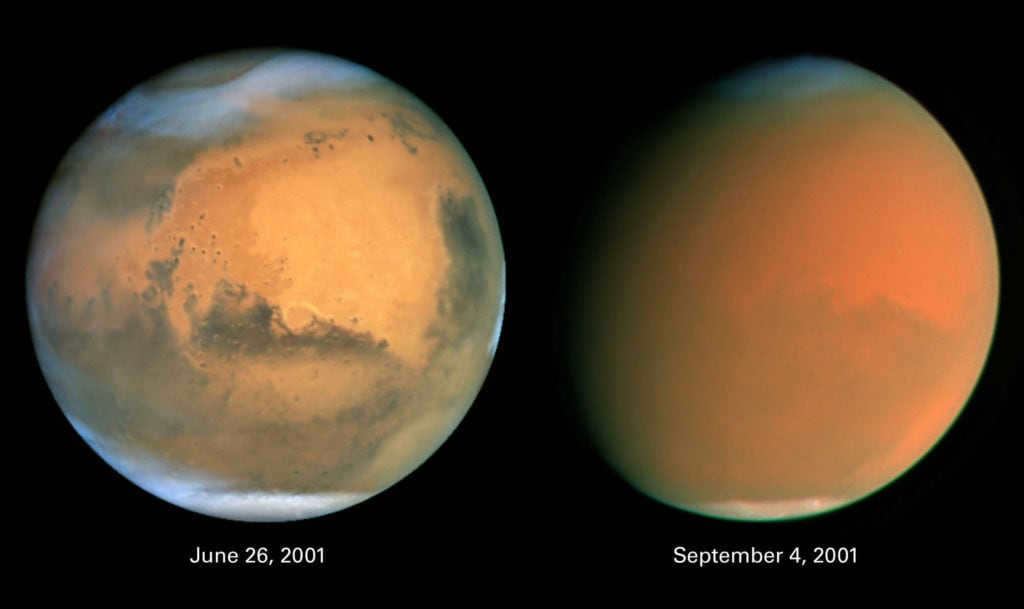
The polar caps of Mars go through seasonal variations. If the size of the North cap increases, it means that the South cap decreases and vice versa. The diameter of the stable part of the North Pole’s “headdress” measures around 1000 km. The ice “crust” can be as thick as 3.7 km. The maximum spread of the cap fields reaches up to 50 degrees of northern or southern latitude on Mars.
Interestingly, the South Polar Cap starts to emit vapor when it gets heated. During the spring melting, unique geysers form, releasing streams of carbon dioxide into the planet’s atmosphere along with sand, dust, and mud.
“Oceans” and “land masses”
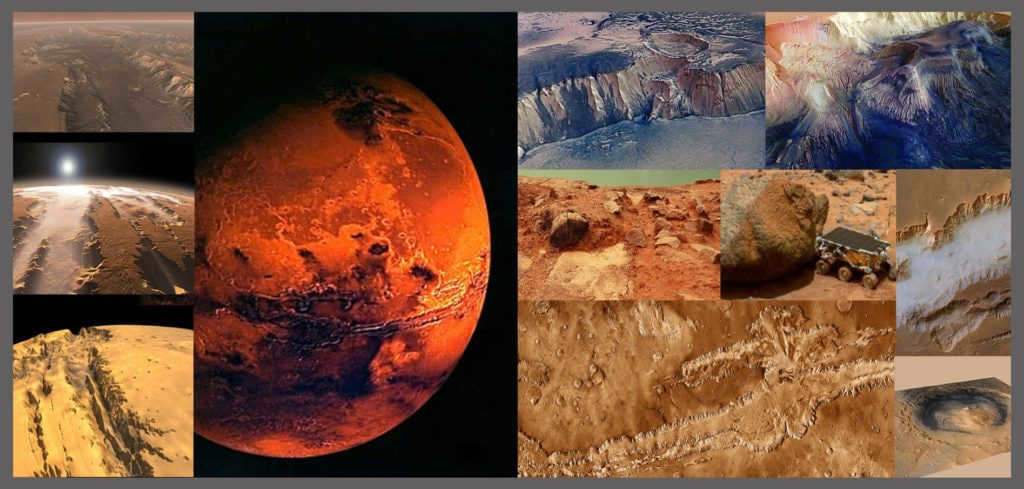
Mars, often referred to as the Red Planet, displays a fascinating geological contrast between its northern and southern regions. The southern part is characterized by elevated terrains and numerous impact craters, giving it a darker appearance resembling “seas”. In contrast, the northern part features smoother and lighter landscapes, reminiscent of “continents”.
The exact cause behind this stark difference remains a mystery. Some experts speculate that it could be attributed to tectonic plate shifts or perhaps the result of a catastrophic cosmic event.

By utilizing specialized equipment to study the surface of Mars, scientists have discovered compelling evidence of the planet’s water resources:
- Dry riverbeds.
- River channels that are visible above the ground.
- A river delta in the Eberswalde crater region, covering an area of 115 km2. The length of the channel exceeds 60 km.
- Minerals that have formed as a result of water activity.
- Ice deposits.
- Fresh indications of flowing saltwater.
- Remnants of a dried-up water stream.
- Rocks that have been shaped by water.
- A subglacial lake situated beneath a layer of ice, with a depth of 1.5 km.
Interesting fact: Mars is home to wide and deep wells, some of which exceed 100 meters in diameter and length.
Soil
The ground is called soil. It is a mixture of minerals, organic matter, gases, liquids, and organisms that together support life. Soil provides a habitat for plants, animals, and microorganisms, and it plays a vital role in the carbon cycle and in maintaining the balance of ecosystems. The composition and properties of soil vary depending on factors such as climate, geology, and land use. Understanding soil and its characteristics is important for agriculture, construction, and environmental management.
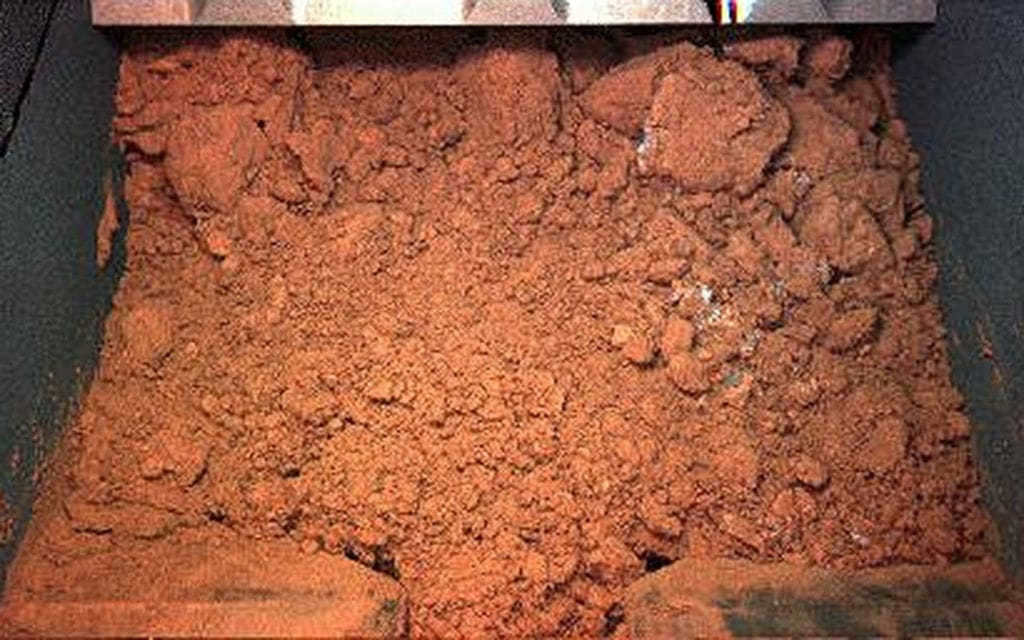
Without delving into the specifics of geology and chemistry, it can be confidently stated that “the soil on Mars is suitable for agricultural purposes.” This assertion comes from American specialist S. Kuneivs, who arrived at this conclusion after conducting a series of laboratory studies. All the necessary components required for the growth and development of cultivated plants are present in the Martian soil.
Did you know?: One of the most groundbreaking and historic moments in space exploration occurred in 2008 when the Phoenix lander successfully extracted water from the Martian soil.
What is the origin of the name Mars?

Mars obtained its name from the Roman god of war, as a result of its crimson color. This particular shade certainly evokes thoughts of intense battles and ruthless combat.
It is intriguing to trace the origins of the planet’s name and the individuals it was named after in ancient times:
- Egypt – “Gor Dashr” (Mountain Red).
- Jews – “Maadim” (blushing).
- Babylon – “Nergal” (god of evil and the underworld, star of death).
- India – “Mangala” (god of war).
- Greece – “Ares” (god of war) or “Pyrois” (fiery).
Subsequently, the two moons of the planet were christened with the monikers of Ares’ offspring: “Phobos” (representing fear) and “Deimos” (symbolizing terror). And that’s not all: it’s worth noting that March, in accordance with ancient Roman traditions, is considered the most favorable time to initiate a conflict. It’s fascinating to observe the origins of the name for the initial month of spring.
What is the reason behind Mars’ reddish hue?
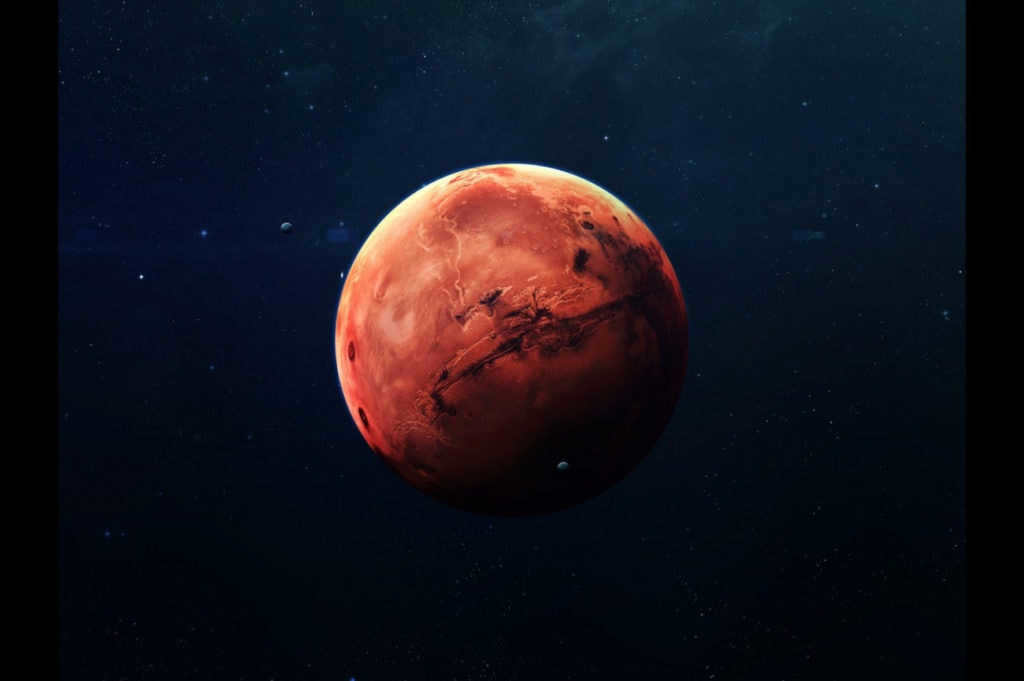

The red color of the planet is caused by iron oxide, commonly known as rust, which is the main component of the dust on Mars. This iron oxide covers the surface of Mars in different layers, ranging from a few millimeters to two meters in thickness (such as the Farside Highlands). Due to the winds on Mars that create upward air currents, the iron oxide particles are lifted into the atmosphere, making them visible from outer space.
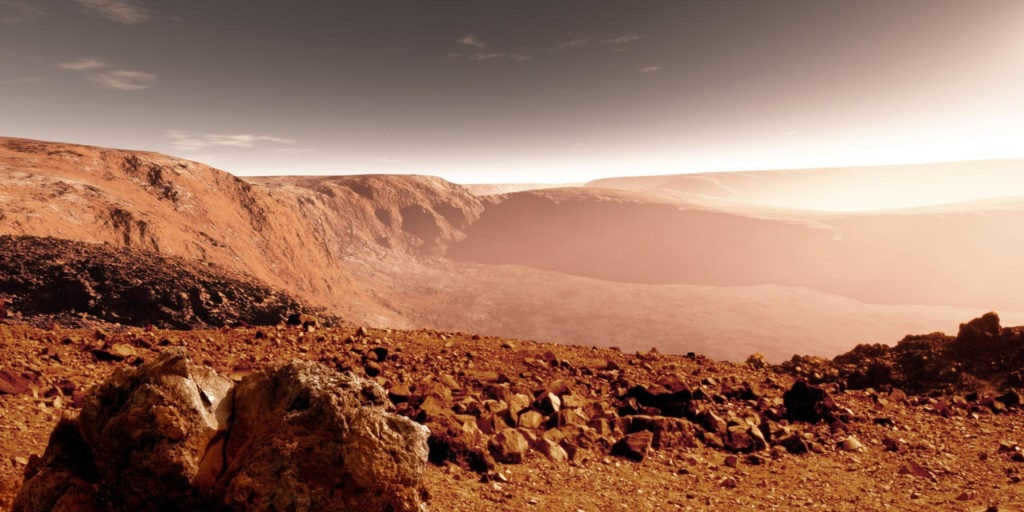
Interestingly, the Martian surface displays a wide range of hues: yellow, brown, golden, brown, red, green. The specific coloration is determined by the chemical composition of the soil.
The enigma that has puzzled the greatest minds of humanity for millennia was finally unraveled through spectral analysis conducted by the instruments aboard the interplanetary spacecraft “Mars Express”.
Storms Occurring on the Planet Mars

The constant winds on Mars are a result of its small size, thin atmosphere, and very low pressure. Powerful streams blow across the planet at speeds of up to 100 m/sec. These winds are strongest in early summer, when there is a significant temperature difference between the Northern and Southern Hemispheres.
Martian storms are characterized by huge flows of dust that are loosely held by gravity. The air vortices that sweep across the surface of the planet are incredibly powerful and exceed all known limits. When observed from space, the entire planet is enveloped in yellow clouds.
The duration of dust storms can range from 50 to 100 days. On certain occasions, particularly during perihelion (the point in its orbit when a celestial body is closest to the Sun), these storms can become global in scale. This happens more frequently than anticipated, occurring approximately once every 1.88 Earth years.
Dust whirlwinds
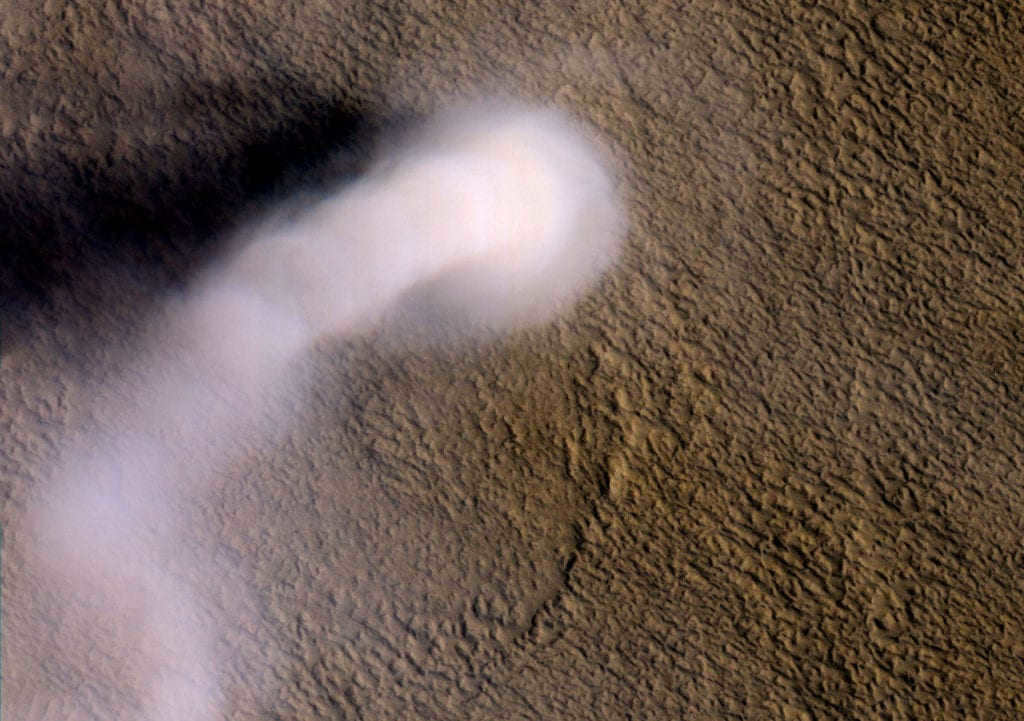
There exists another fascinating phenomenon reminiscent of tornadoes found on Earth. Dust whirlwinds, more commonly known as dust devils, are present. These dust towers transport the atmosphere along with gases and water from the surface of Mars. The quantity of these upright, rapidly rotating vertical currents reaches into the millions: a single square kilometer of space produces a whirlwind every few seconds.
All of this would be insignificant, except that storms and whirlwinds generate static electricity discharges due to the friction produced by the dust, which has a negative impact on technical devices. During natural disasters, tiny grains of sand can infiltrate the equipment. They also coat and “seal” the surfaces of solar panels and optical instruments, thereby obstructing the functioning of research equipment.
Did you know: the breakdown of the Mars rover Opportunity, which was officially declared on February 13, 2019, was a significant setback for humanity. The public’s interest in the rover’s fate was intensified by its last poignant message on social media, where it communicated its dwindling battery power and the encroaching darkness. This remarkable rover had been exploring the Martian surface for an impressive 15 years, but unfortunately, a severe storm and frigid temperatures ultimately silenced its communication.
Mars’s Distinctive Landmarks
Mars is abundant in distinctive features, some of which are unparalleled in the entire solar system. Prospective explorers will have plenty to witness on the neighboring planet. Even a mere enumeration of these landmarks is bound to leave a lasting impact.
The Martian Mount Olympus
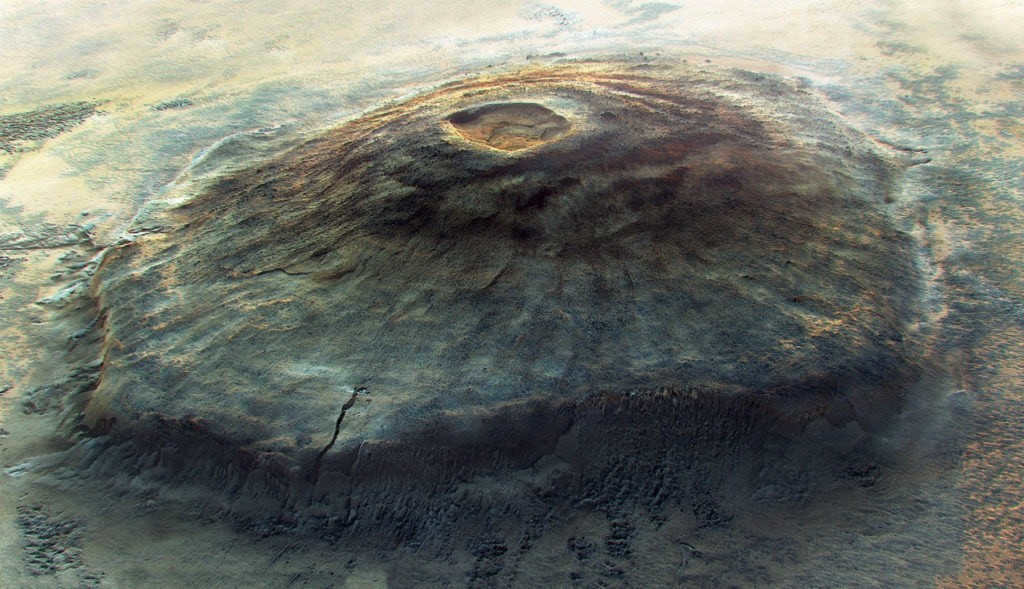
Undoubtedly, the most famous attraction is Mount Olympus, which is home to a dormant volcano. Standing at a staggering height of 26.2 km and spanning up to 85 km wide, this mountain is truly a sight to behold. Its crater has been carved out to a depth of 3 km.
The Majestic Canyons of Mariner Valley

The Mariner Valley exhibits canyons that stretch for up to 3,000 kilometers in length. Among these canyons, the most remarkable one is the Geba Canyon, which reaches an astonishing depth of 8 kilometers. The formation process of this canyon still remains an enigma.
Another noteworthy feature of the Mariner Valley is the Labyrinth of Night, aptly named due to its intricate formation resembling a system of interconnected canyons.
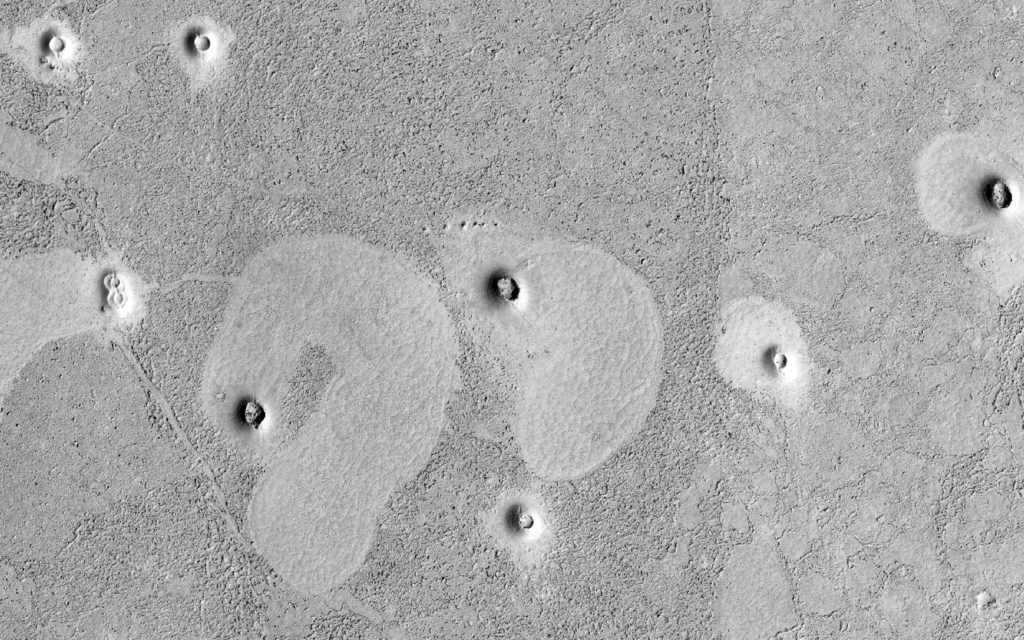
Elysium, a cluster of long-dormant volcanoes, is home to a collection of morphological structures with bizarre shapes. Among them are the Fossa Medusa, the “Spider,” the “Lace,” and the “Channel patterns.” These structures resemble frozen traces of drops creating craters that can reach up to 16 km in diameter. Near the equator, there is an intriguing mystery: the sediments in this area do not reflect radio waves. Additionally, near the poles, there are vertical ice cliffs that add to the unique beauty of Mars.
The endless variety of forms and landscapes on this extraordinary planet would surely captivate even the most discerning futurist artist. Moreover, there are still undiscovered “white spots” on Mars, eagerly awaiting their explorers.
Does Mars support any form of life?
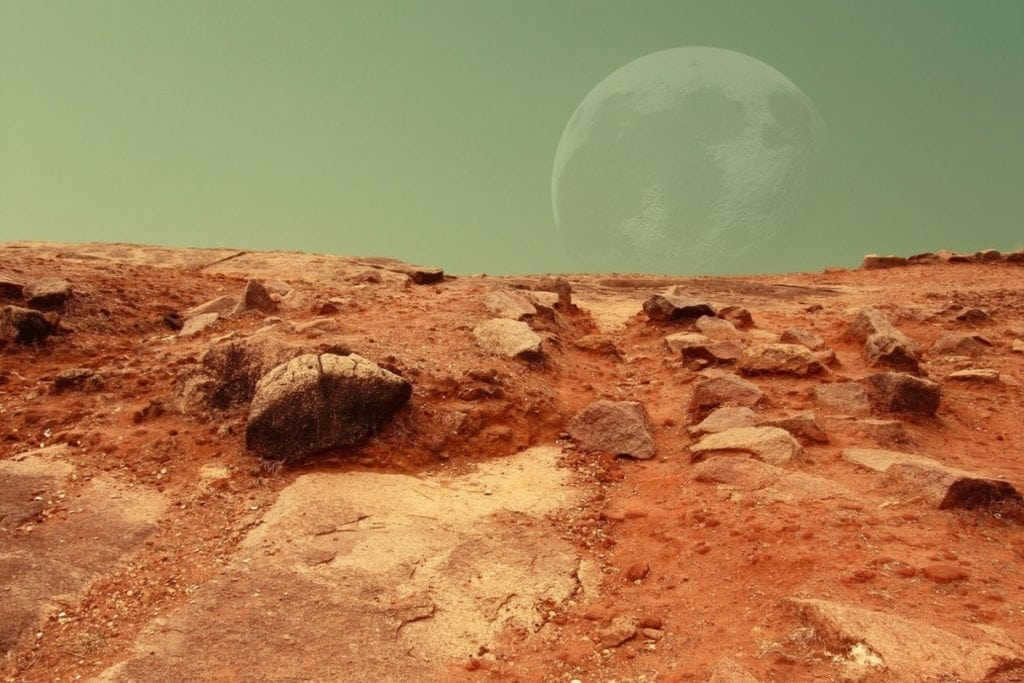
Is there any possibility of life existing on Mars? This is a question that has yet to be definitively answered. There are several factors that make it a plausible scenario.
Interesting fact: Scientists have conducted a series of experiments to determine if bacteria, algae, and lichens can grow in Martian conditions. These conditions have been recreated artificially in laboratories. The results have been promising, with one microorganism showing better adaptability to the Martian climate than to Earth’s climate.
It’s possible that in the caves and crevices of Mars, there are or have been conditions suitable for the emergence of life. The question still remains unanswered.
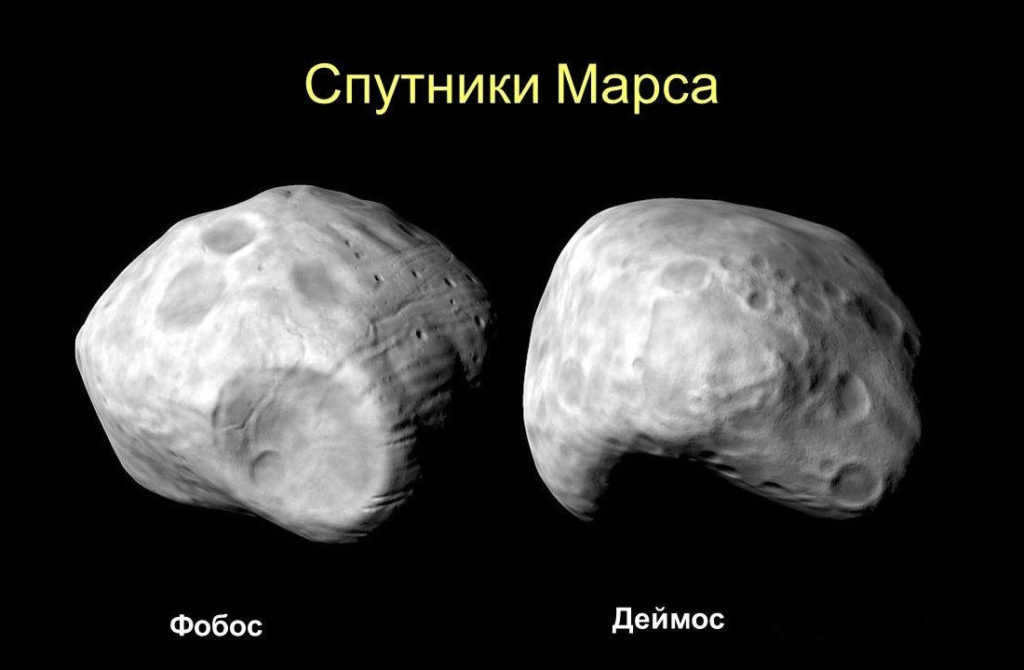
Mars, our closest celestial companion, possesses a pair of satellites known as Phobos and Deimos.
Characteristics of the Physical and Orbital Features of Mars’ Satellites

The history and future of Mars’ moons
The opinions of space scientists regarding the origins of the Martian moons are conflicting. It is possible that in the past, they were asteroids drawn in by the planet’s gravitational pull; the possibility of their formation through collision cannot be ruled out.
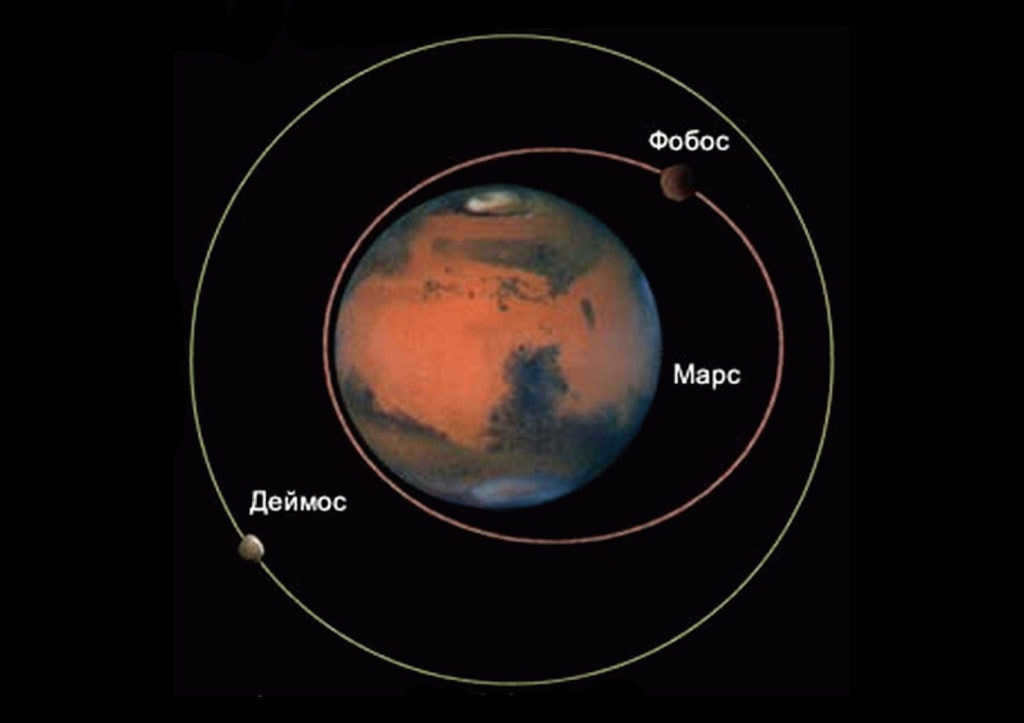
Regarding the future, experts are in agreement: Phobos is facing potential destruction, which may result in the formation of a planetary ring encircling Mars. Over time, its components will gradually descend onto the planet. Deimos, on the other hand, has a different outlook as it is gradually distancing itself from Mars.
Did you know? Way before Phobos and Deimos were discovered by American astronomer A. Hall in August 1877, their existence was actually predicted by D. Swift and F. Voltaire. Swift, the Anglo-Irish writer famous for his book “Gulliver’s Travels,” even mentioned the orbits and orbital periods of these satellites in his work. Although not entirely accurate, their foresight was acknowledged by naming two craters on the surface of Deimos after them.
The Egyptians were the first to observe our closest cosmic neighbor in ancient times. The Babylonians, Greeks, Hindus, and Chinese later joined in, along with Arab astronomers. During that time, astronomical treatises and reports focused on basic measurements and regular monitoring of the planet’s motion.
Medieval scientists made significant contributions to the understanding of the solar system’s geometry. Copernicus’ heliocentric system accurately positioned the Sun and planets.
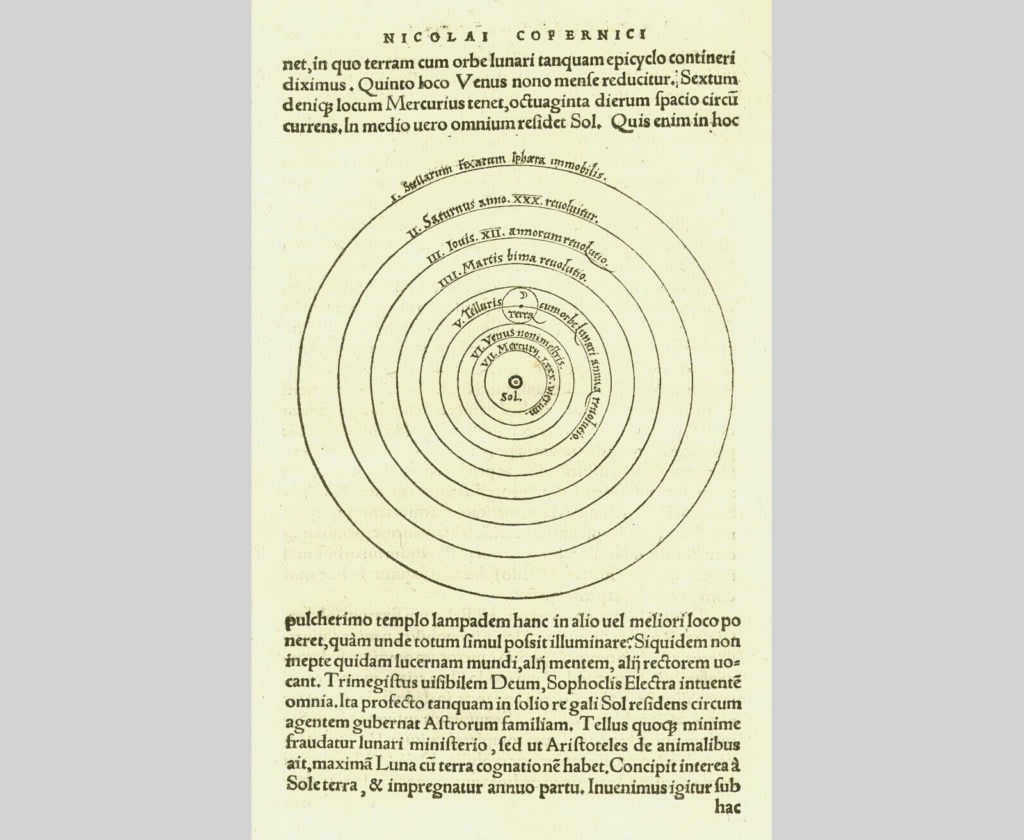
With the invention of telescopes, a new era began in the exploration of Mars. Galileo Galilei was the first to master the art of using instruments for scientific research. His discoveries were built upon by Giovanni Cassini, Tycho Brahe, and Johannes Kepler. They created maps of the Martian surface and even discovered the planet’s satellites. Through precise calculations, they were able to gain a better understanding of Mars. Today, astronomical observatories continue to study the Red Planet.
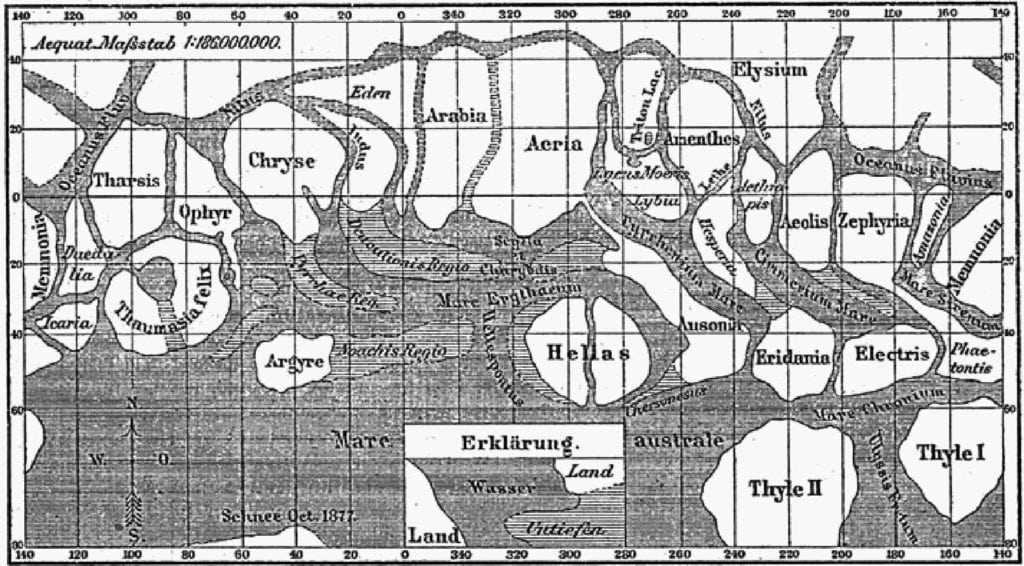

A new phase of research began with the launch of space rockets and vehicles, marking the start of the rivalry between the USSR and the USA. Numerous interplanetary space stations were sent to Mars for orbital research, as well as probes and Mars rovers for landing. Currently, there are eight active missions with plans to send seven more in the near future.
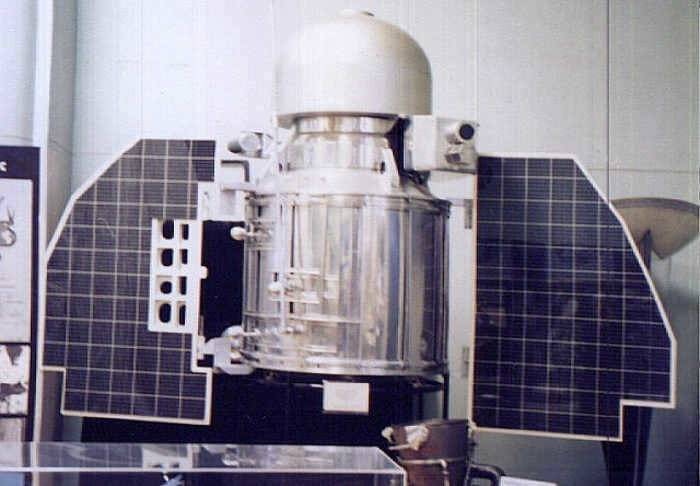
- 1960. USSR. The Marsnik program experienced failure as the “Mars 1960A” and “Mars 1960B” were lost due to an accident on a Molniya rocket.
- 1962-63. Russia. Two missions, “Mars 1962A” and “Mars 1962B,” were unsuccessful due to a failure in the upper stage. However, “Mars-1” successfully flew past the planet before losing communication with the spacecraft.
- 1964. Russia. Another mission, “Probe 2,” also missed its target.
- United States. The “Mariner-3” mission encountered difficulties with the opening of the solar panels and the separation of the head fairing. However, the “Mariner-4” mission successfully captured the first close-range photos of Mars.

- 1969. The Soviet Union. The missions “Mars 1969A” and “Mars 1969B” were unable to complete their objectives due to a mishap during the launch.
- The United States. “Mariner 6 and Mariner 7 conducted studies of the Martian atmosphere and captured images.
- 1971. USSR. The launch of the “Cosmos-419” failed. The “Mars-2” probe crashed while approaching the planet’s surface. Although the “Mars-3” successfully made its first soft landing, it immediately lost contact. U.S.. The launch of “Mariner-8” also encountered an accident. However, “Mariner-9” became the first artificial satellite to map the surface of Mars.
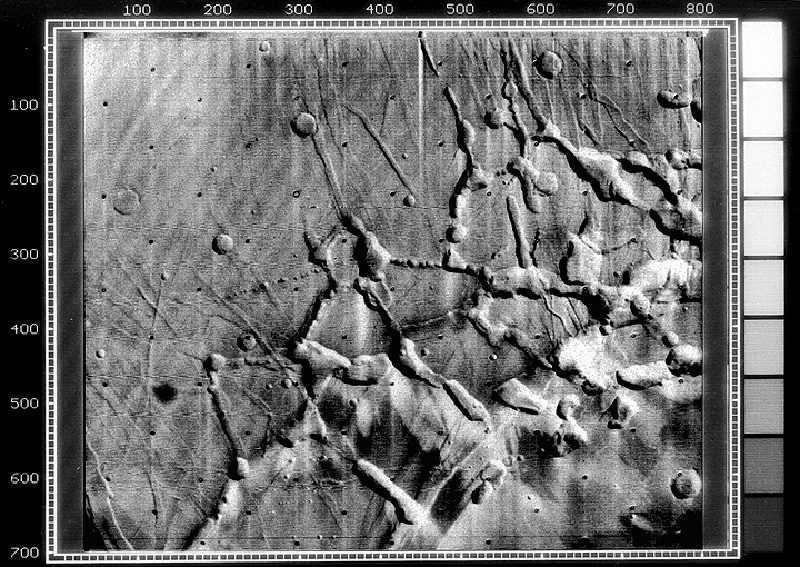
- 1976. United States of America. The missions “Viking-1” and “Viking-2” successfully carry out exploration of the Martian surface.
- 1988. Union of Soviet Socialist Republics. The missions “Phobos-1” and “Phobos-2” become the first vehicles to explore the satellites of Mars. The first mission loses contact, while the second mission captures 37 photos of Phobos.
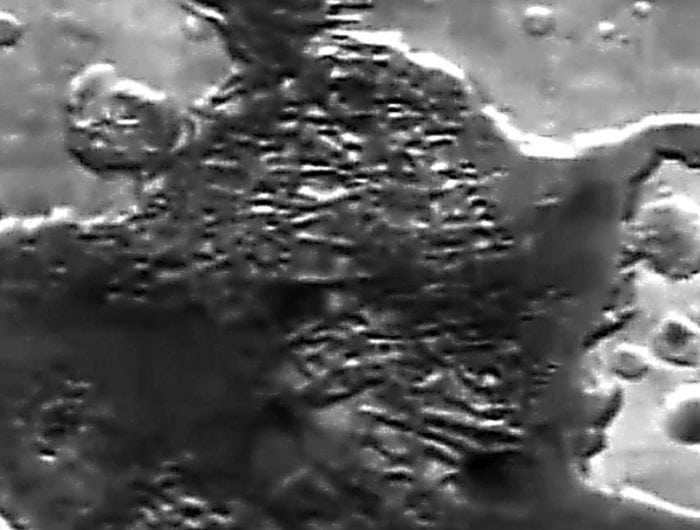
- 1992. United States of America. The mission “Mars Observer” fails to establish contact.
- 1996. Russia. The “Mars-96” rocket experiences an upper stage failure.
- USA. “Mars Global Surveyor” – one of the most successful missions to Mars, captured images of Mars rover tracks and artificial satellite footprints. “Mars Pathfinder” and the Sojourner rover conducted experiments to improve the landing on the Martian surface, and successfully launched the first Mars rover.
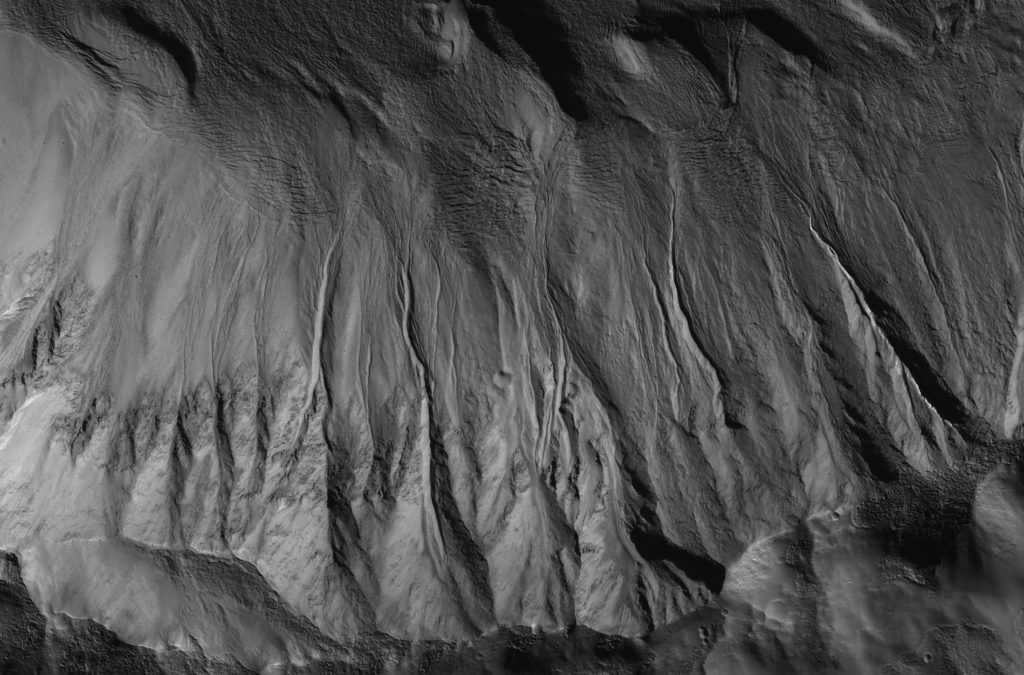
- 1998. Japan. “Nozomi” fails to enter Martian orbit.
- 1999. USA. Three attempts to achieve coordinated functionality from three spacecraft: two crashes and loss of communication. The Climate Research Complex did not fulfill its designated mission.
- 2001. USA. “Mars Odyssey, an operational man-made satellite.
- 2003. USA. “Spirit” – a Mars rover in operation until 2010. “Opportunity” – the most successful among the Mars rovers. 15 years of operation. European Union. “Beagle 2” lost contact after landing. “Mars Express” – an operational man-made satellite.
- 2005. UNITED STATES. The Mars Reconnaissance Orbiter continues to carry out its assigned task.
- 2007. USA. “Phoenix” landed near the pole and discovered water on Mars.
- 2011. Russia-China. “Phobos-Grunt” and “Inho-1” crashed upon leaving Earth’s orbit. USA. “Curiosity” is an operational Mars rover.
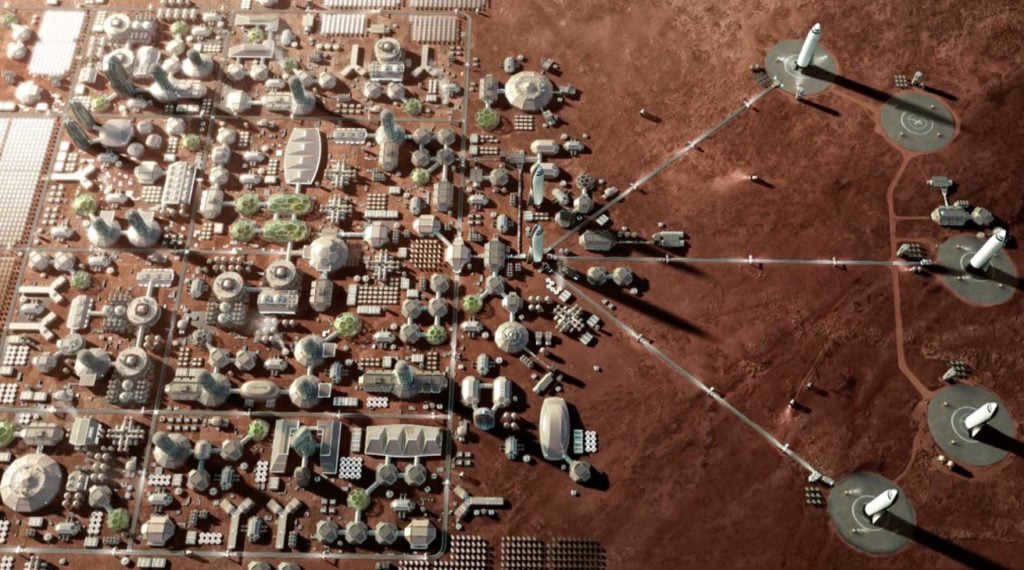
By the years 2030 – 2033, major players such as NASA USA, Roscosmos Russia, and the European Space Agency are considering the possibility of launching a crewed spacecraft. The United Arab Emirates is also working on the “Mars-2117” project, which aims to establish a colony on Mars in the future.
Several private organizations are also interested in this field, with Elon Musk, the founder of SpaceX, being particularly active. He is assertively promoting his commercial projects and highlighting their financial potential.
While there are numerous challenges and difficulties, the allure of the goals is undeniable. Who wouldn’t want to be the first person to set foot on Mars? Recruitment for space crews is already underway, and it’s possible that some of the future astronauts will have the opportunity to follow in the footsteps of the famous Neil Armstrong.
If you come across any mistakes, kindly select the text and press Ctrl+Enter.
Mars, the fourth planet from the Sun, bears many similarities to Earth. It was named after the ancient Roman deity of war. Its nickname, the Red Planet, stems from its vibrant hue, caused by iron oxide. Mars captivates scientists as a potential candidate for colonization and terraforming. Let’s delve deeper into this intriguing planet.
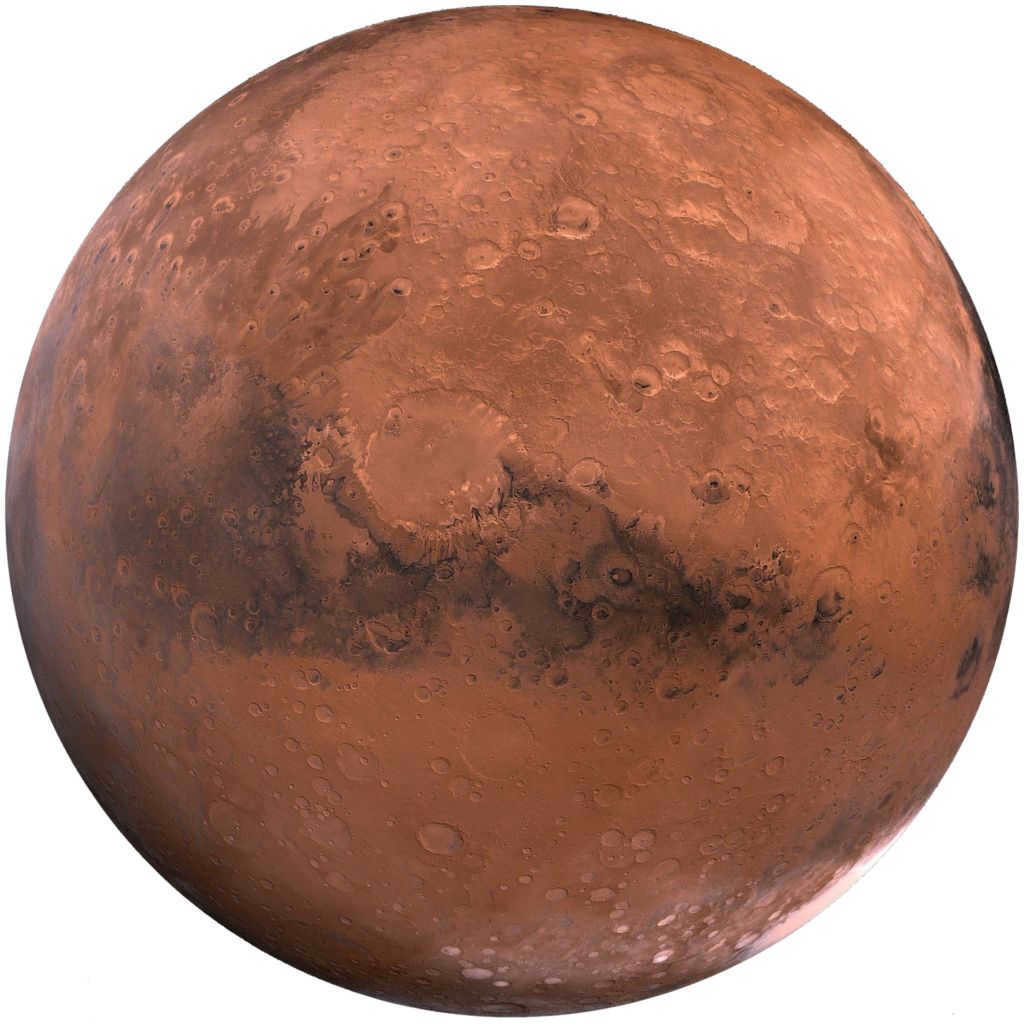
Planet’s Characteristics
Here are the orbital characteristics of the planet:
- The distance from the Sun to Mars is at a minimum of 206 million kilometers;
- The distance from Mars to the Sun is over 249 million kilometers at maximum;
- The length of the major semi-major axis is approximately 2.28*10 11 meters;
- The eccentricity of the orbit is greater than 0.09;
- The duration of the year (time of orbit around the Sun) is almost 669 days;
- The orbital velocity is 24 kilometers per second;
- The inclination of the axis is slightly over 25 degrees (causing clear changes of seasons);
- The radius of Mars at the equator is 3 thousand 392 km;
- The radius of Mars at the poles is 3,376 kilometers.
- The surface area of Mars is over 144 million square kilometers.
- The volume of Mars is 163 billion cubic kilometers.
- The mass of Mars is 6.41*10^20 tons (641 quintillion).
- The gravitational force on Mars is 3.7 meters per second squared.
- The first space velocity of Mars is 3.55 kilometers per second.
- The second space velocity of Mars is 5.03 kilometers per second.
- The duration of a day on Mars (period of rotation around the axis) is 24 hours and 37 minutes.
- The apparent stellar magnitude of Mars ranges from nearly -3 to nearly 1.9.
- The surface temperature of Mars ranges from -153 to 35 degrees Celsius.
- The atmospheric pressure at the surface of Mars is 6.5 millimeters of mercury.
- The atmosphere of Mars is composed of 95% carbon dioxide and 2.7% nitrogen. The remaining gases include argon, oxygen, water vapor, nitrogen oxide, and others.
Characteristics of Mars
Mars, one of the planets in our solar system, is approximately half the size of Earth. It has a slightly smaller polar radius compared to its equatorial radius, which is a result of compression. The mass of Mars is ten times less than that of Earth, and its density is only 70% of Earth’s density. Due to its smaller mass, the gravity on Mars is two and a half times weaker than Earth’s gravity and is similar to the gravity on Mercury.
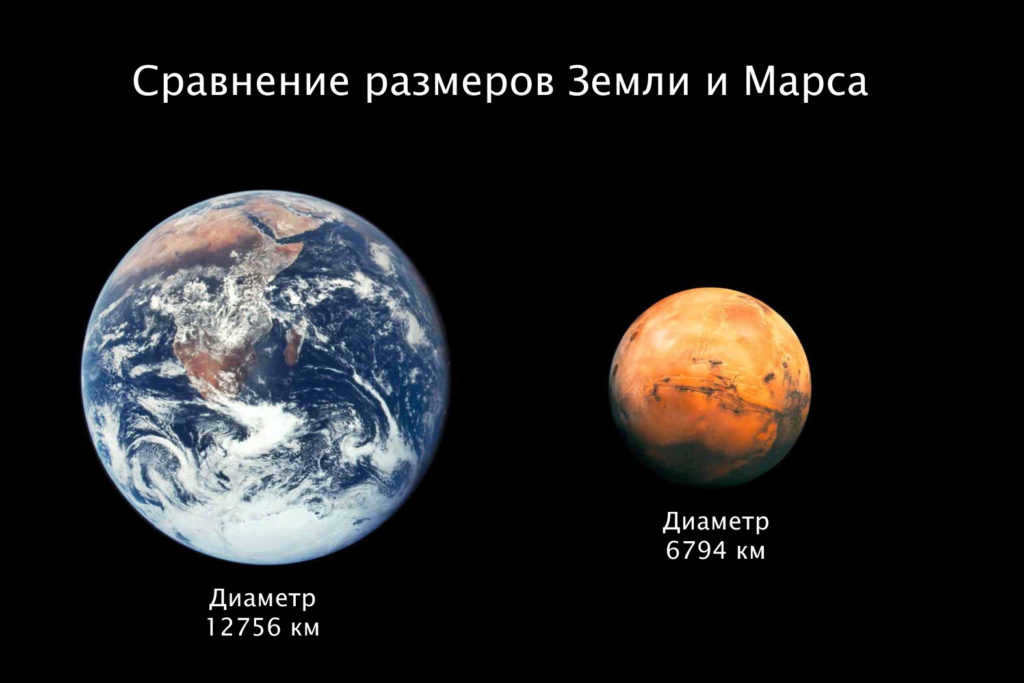
It is uncertain whether the physical characteristics of Mars can lead to the development of various illnesses in humans during long-term residency on the planet. In the event of any adverse effects from the reduced gravity, there are considerations for utilizing centrifuges that replicate the normal gravitational conditions.
A day on Mars lasts 37 minutes longer than a day on Earth. The term “sol” is used to describe the duration of time it takes for the planet to complete one rotation on its axis.
The unique orbital features of Mars
Mars and Earth showcase distinct variations in their respective orbits. In particular, the Red Planet is positioned at a distance from the Sun that is 1.5 times greater than that of Earth. As a result of this disparity, the length of a Martian year is nearly 687 days. Moreover, the planet’s proximity to the Sun fluctuates within wider ranges due to Mars having a slightly elongated orbit compared to Earth’s.
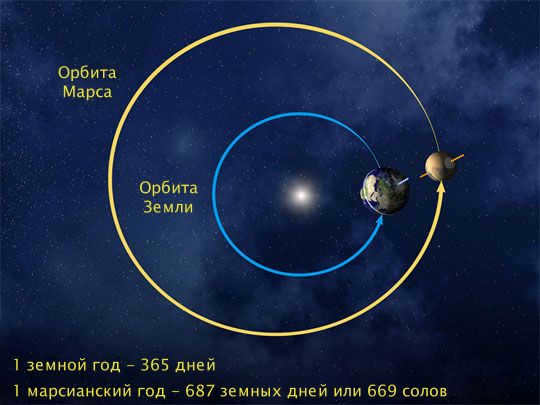
Due to the inclination of Mars’ axis, it experiences significant seasonal weather changes. The eccentricity of its orbit also plays a role in the planet’s orbital motion. As a result, the northern hemisphere has a 6-month summer, a 7-month spring, a little over 5 months of fall, and only 4 months of winter. In contrast, the southern hemisphere experiences the opposite: the longest season is fall, while summer is the shortest.
The Martian orbit also influences its weather patterns, with dust storms forming due to the orbit’s elongation and the inclination of the ecliptic. These storms can engulf the entire surface of the planet. The frequency of these weather events increases as Mars approaches closer to the Sun.
Chemical composition
The chemical makeup of Mars mimics that of Earth, featuring a comparable division into core, mantle, and crust. The core of Mars is composed of notable amounts of nickel, sulfur, and iron. Silicate compounds dominate the mantle region. The Martian crust contains various elements, including:
- iron;
- magnesium;
- oxygen;
- calcium;
- silicon;
- potassium;
- aluminum.
Mars shares a similar structure to Earth, with significant concentrations of iron and silicon. In the mantle region, the pressure can reach up to 17 GPa. Scientists believe that the core of Mars is in a liquid state.
Mars Moons
Mars is home to two moons, Phobos and Deimos, both named after the Greek words for “fear” and “terror” respectively. Phobos, the larger of the two, completes an orbit around the planet in just 7.5 hours. It has a surface area of 1600 km2 and a radius of only 11 km. Despite its small size, this celestial body weighs more than 10 trillion tons. Phobos always presents the same face to Mars as it rotates at a distance of 6,000 kilometers from the planet. Interestingly, in the Martian sky, Phobos rises “backwards” in the west and sets in the east. It manages to rise and set twice in a day.
Over time, Phobos is gradually getting closer to Mars. Every 100,000 years, the Martian moon moves about 1.8 meters closer to the planet. In approximately 10 million years, Phobos will eventually disintegrate into small pieces, forming a ring of debris around Mars.
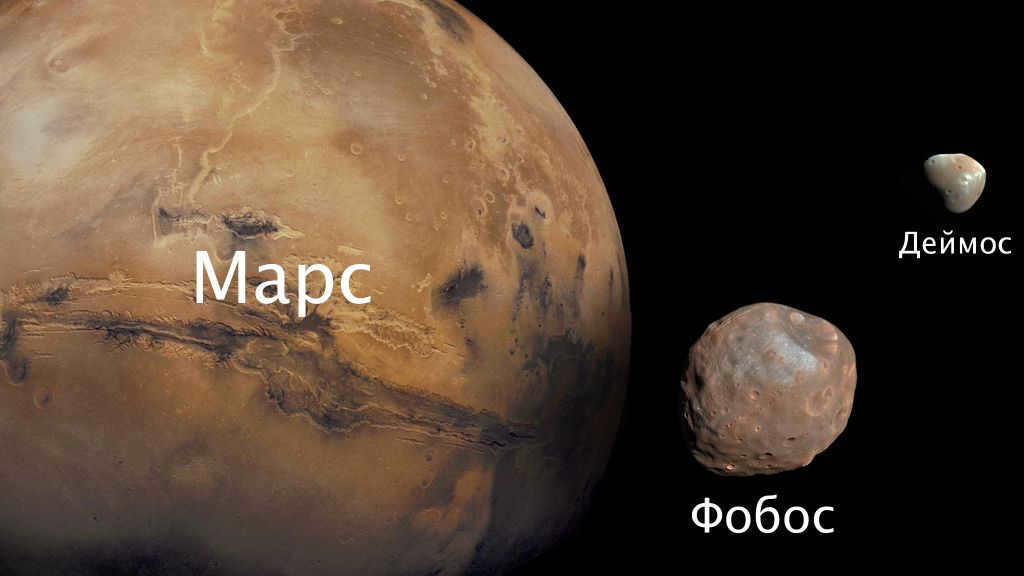
Deimos, known as the “terror” satellite, is considerably tinier in comparison: measuring a mere 12.4 km in diameter and weighing just over a trillion tons. The average distance between the satellite and Mars is approximately 23.5 thousand kilometers. Its unique shape resembles that of a triaxial ellipsoid. It is worth noting that Deimos holds the title for being the smallest satellite within the entire solar system.
Conditions of the atmosphere and temperature on the planet Mars
Mars has a highly rarefied atmosphere that has a significantly different composition compared to Earth. The atmospheric pressure on Mars is about 6-6.5 mm Hg, which is similar to the pressure at an altitude of 35 km on Earth. The homogeneous atmosphere extends to a height of approximately 11 km, and the exosphere begins at around 250 km. The total mass of Mars’ atmosphere is about 25 trillion tons. However, due to its weak magnetic field, the solar wind causes gases to dissipate into interplanetary space, at a rate of approximately 9 tons per day.
Carbon dioxide makes up 95% of the atmospheric composition on Mars, making it the most abundant gaseous compound under the planet’s gravity. Volcanic eruptions are the primary source of carbon dioxide, continuously replenishing the Martian atmosphere. However, lighter gases are constantly being stripped away by the solar wind, leaving behind a predominantly carbon dioxide-rich environment. Ozone is also found in the Martian air, although its levels fluctuate due to the unstable temperature variations on the planet.
Recently, there have been reports of unknown methane emissions occurring on the planet. Studies have revealed that up to 270 tons of this gas can be released into the atmosphere per year from the depths of the planet. Additionally, satellite data has detected traces of ammonia.
In the Martian atmosphere, clouds of water vapor form at a height of 10-30 km. These clouds are more abundant near the equator. High-altitude clouds consist of condensed carbon dioxide.
Dust is a constant presence in the atmosphere. Due to the planet’s low gravity, even dust microparticles can rise as high as 50 km. The strongest winds occur in late spring and early summer, reaching speeds of up to 100 km/hour. The large temperature fluctuations throughout the day can also give rise to dust whirlwinds.
Sunset and sunrise on Mars appear blue, unlike the pink hues seen on Earth.
It is hypothesized that Mars experienced a more hospitable climate in its history. Presently, the average temperature on Mars is -63°C. At the equator, temperatures can reach 27-35°C, but during winter nights, they can drop to around -100-120°C. Closer to the poles, the frost is even more extreme. As a result, Mars is significantly colder than Antarctica.
The terrain of Mars
Mars, an arid desert planet within our solar system, features a diverse landscape filled with a plethora of volcanoes (both active and dormant) as well as craters. It is believed that the primary constituent of the dust layering the planet’s surface is iron oxide.
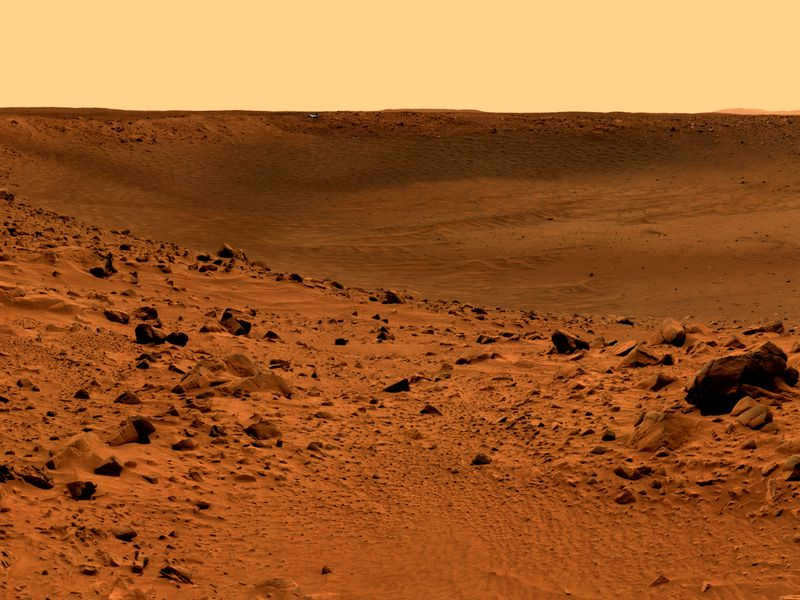
Craters on the planet Mars remain well preserved due to the absence of weathering and strong plate tectonics. The lack of rain and limited plate movement contribute to the preservation of these natural features.
Optical illusions
The surface of Mars holds numerous enigmas for Earth’s inhabitants, as it seems that the fourth planet is reluctant to reveal its secrets and instead teases us with illusions. Among the most common illusions are the so-called channels and “faces,” which have given rise to various conspiracy theories. One of the most outlandish claims is that the Americans are hiding a Martian civilization from the rest of the world. Additionally, some amateurs have claimed to have discovered a supposed “biostation Alpha.”
Martian Canals
Canals are features that scientists first became aware of in the late 19th century and continued to study until the 1970s. They were described as thin lines that formed a global network. Italian astronomers Secchi and Schiaparelli were the first to observe these channels.
In the early 20th century, efforts were made to photograph the canals. Several hypotheses were put forward:
- The canals are structures of Martian origin.
- The observed objects are simply natural geological formations.
- The canals are optical illusions.
In 1975, American scientists proved that the canals are indeed optical illusions.
The Martian Sphinx
There is a distinctive hill on Mars that has been captured in images and bears a striking resemblance to a human face. These images have sparked a multitude of pseudoscientific and fantastical explanations.
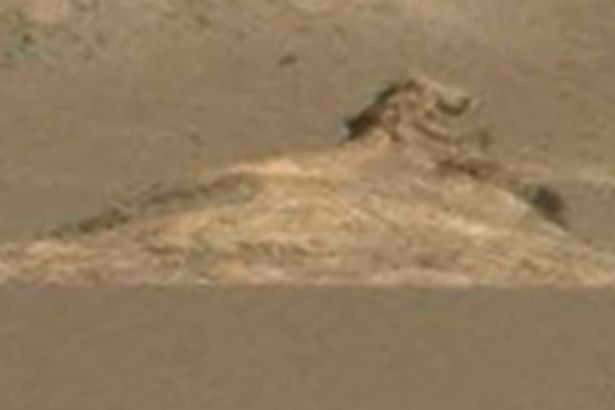
When exploring Mars with automated stations, scientists discovered that the so-called “face” on the planet’s surface is actually just a trick of light.
Polar Ice Caps
In close proximity to the poles of Mars, there are regions that contain significant amounts of ice and frozen carbon dioxide. During the Martian spring, the polar ice cap in the northern hemisphere spans a diameter of 1,500 km and has a volume of approximately 1.2 million km3. It can extend up to a latitude of 50°.
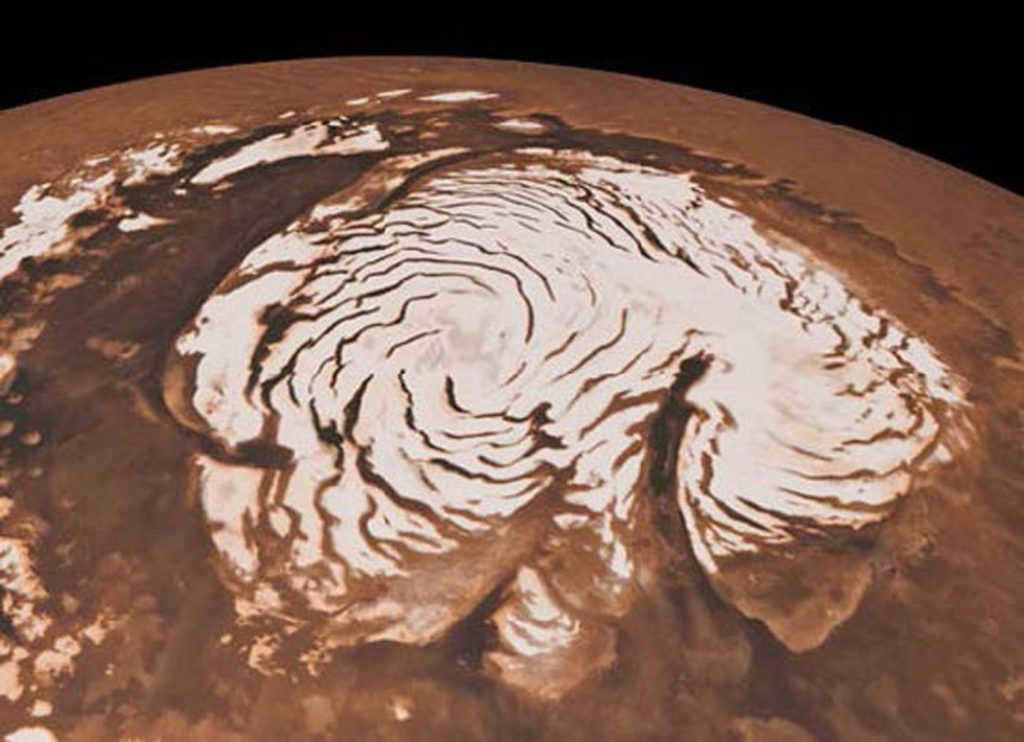
The diameter of the ice cap located at the South Pole is considerably smaller: during the spring season, its diameter measures around 400 km. This phenomenon can be attributed to the fact that during summer, the southern hemisphere moves closer to the Sun, allowing the ice masses to partially melt.
Seas and continents
Mars does not have any open water bodies. Instead, the “continents” on the planet refer to the expansive, light-colored regions of its surface. Conversely, the darker areas are known as the “seas”.

The northern hemisphere of Mars is home to the majority of the planet’s “seas”. The Acidali Sea and the Great Sirt are the two main “seas” found in the northern region of our celestial neighboring planet.
Dry riverbeds and deep wells
There exist a considerable number of features on the Red Planet that bear resemblance to riverbeds. One theory suggests that their formation was the result of a cosmic catastrophe. However, the presence of these formations does not conclusively prove the existence of rivers on Mars. It is only known that these formations could have developed over an extended period of time.
Additionally, inverted channels have been discovered on Mars. These channels are slightly elevated.
Data from the images captured by the Mars rovers indicate that liquid water once existed on Mars. This is supported by the presence of minerals that could only have formed in the presence of water and through prolonged exposure to it.
The presence of dark-colored streaks on the slopes of Martian highlands may suggest the occasional appearance of salt water on the surface. This occurrence typically happens during warm periods, but the water disappears with the onset of winter.
Soil
The soil composition varies from location to location and has been analyzed by the Mars rovers. Silica and iron oxide hydrate are the primary constituents of the soil, lending it a distinct reddish hue. Additionally, Martian soil contains sulfur, calcium, and aluminum salts.
Furthermore, data from the American Phoenix probe reveals that the acidity and other characteristics of Martian soil are similar to those found on Earth. This suggests that, in theory, plants could be cultivated in this soil. Additionally, space probes have detected the presence of ice below the surface in certain regions of the planet.
Exciting Martian Destinations
Mars boasts a plethora of captivating attractions that are sure to captivate future space tourists.
Mount Olympus
Located near the equator, Mount Olympus is an inactive Martian volcano that stands as the tallest mountain in the entire solar system. This natural wonder has been known to scientists for centuries, long before space exploration became a reality.
Reaching an impressive height of 26 kilometers from its base, Olympus towers over its surroundings, surpassing the Earth’s Mauna Kea volcano by 2.5 times. The mountain’s edges feature remarkably steep slopes, measuring approximately 7 kilometers in height. The origins of these steep cliffs continue to puzzle scientists, who speculate that they may have been sculpted by the remnants of an ancient ocean.
The caldera of this volcano spans 85 kilometers in length and 60 kilometers in width. It is quite fascinating to note that the atmospheric pressure at its summit is 50 times lower compared to the planetary surface. This disparity is quite significant, especially when we consider that at the peak of Mount Everest, the atmospheric pressure is only 4 times less. In terms of absolute values, the pressure at the summit of Martian Olympus is nearly equivalent to that of a technical vacuum.
The eruptions of lava on Olympus have been happening for an extended period of time. This can be seen from the impressive width of the dormant volcano, which is 30 times its height. The most recent lava flows on the slopes of Olympus occurred over a span of approximately 2 million years. It is plausible to believe that Olympus may experience another eruption in the near future.
Olympus is in close proximity to other volcanoes of considerable size. The mountain is part of a larger system of ridges known as the “halo of Olympus”. The origins of this system are still unknown.
The Mariner Valley’s Stunning Canyons
In the 1970s, the Mariner 9 lander made a remarkable discovery on Mars – an extensive network of canyons. These valleys stretch for an astonishing 4,500 km and can reach widths of up to 600 km. The depth of this geological wonder is an impressive 11 km, making it the largest canyon in the entire Solar System. A similar depth can be found at the Argo Canyon on Charon, one of Pluto’s moons.
Astronomers believe that these canyons formed during the early stages of Mars’ evolution, as a result of erosion processes. Initially, there was speculation that these canyons were actually part of a network of canals. However, this theory was eventually abandoned after the illusory nature of such channels was proven. Another hypothesis that was dismissed was the idea that the canyons formed due to the destruction of permafrost.
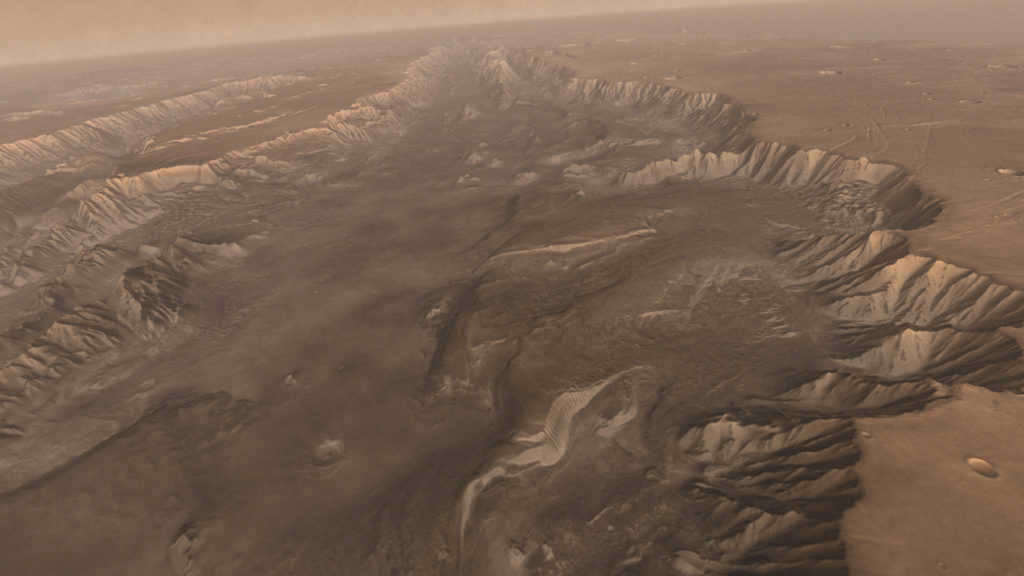
It is probable that the Mariner valleys originated due to the eruption of colossal Martian volcanoes. The Labyrinth of Night came into existence as a result of the processes involved in horizon formation. Subsequently, the topography underwent changes caused by meteorite impacts that melted deposits of solidified carbon dioxide.
During periods when the red planet Mars is at its nearest distance to the Sun, clouds take shape and ascend over the canyon. The cloud zone can stretch for hundreds of kilometers. The clouds consist of minuscule ice crystals. They are dense and can provide shade. In the morning, mist arises above the Labyrinth of Night. It is also composed of ice crystals. The origin of the mist remains unknown.
Storms and Dust Whirlwinds on the Red Planet
Mars experiences frequent dust storms that sweep across its surface. These storms are caused by winds that carry a layer of fine sand, which blankets large portions of the planet. The dust on Mars is incredibly fine, with particles measuring just one micron in diameter and composed mainly of iron oxide. Due to the planet’s relatively weak gravitational force, dust clouds can rise to heights of up to 50 kilometers.
During early summer, the southern region of Mars experiences significant temperature fluctuations. Wind speeds can reach hundreds of meters per second, creating ideal conditions for the formation of extensive dust storms. These storms can sometimes be observed as massive veils, covering nearly the entire planet. The duration of these meteorological events can last for several months.
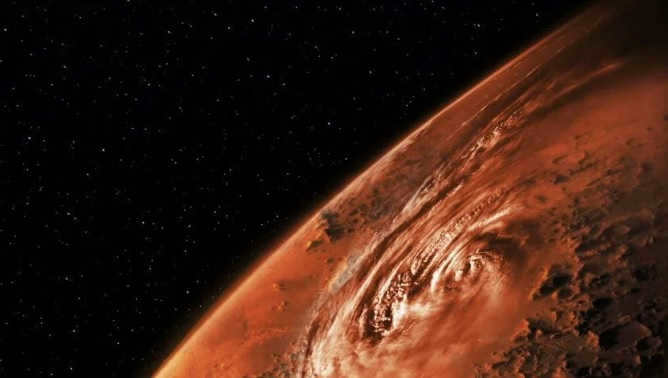
However, the Martian atmosphere has a limited ability to support life. For instance, dust storms are not easily visible from the rovers on Mars, unlike the clear images captured by orbital spacecraft. Storms on the landing sites of space stations were indirectly recorded through changes in temperature, atmospheric pressure, and darkening of the sky.
Tornadoes can emerge unexpectedly, posing a significant obstacle for travelers who arrive on Mars. Furthermore, the electrification potential of dust particles further complicates the situation.
A Comparison of the Sizes of the Nearest Planets
A table is a convenient way to compare the sizes of Mars and Earth.
| Parameter | Earth | Mars |
| Mass | 6*1021 tons | 6.4*1020 tons |
| Radius (average) | 6371 kilometers | 3396 (at the equator) |
| Volume | 1.08 trillion km 3 | 163 billion km 3 |
| Length of the equator circumference | 40008 km | 21327 km |
| Area | 510 million km 2 | 144.3 million km 2 |
Did you know that the jump on Mars would be three times higher than on Earth due to the weaker gravity?
Exploring the History of Mars
The initial records of Mars can be traced back to the ancient Egyptian stargazers’ papyri. The Red Planet, Mars, was well-known to the ancient Babylonians, Greeks, and Romans.
In the 16th century, the renowned astronomer N. Copernicus introduced the heliocentric model, which accurately placed each planet in its position. I. Kepler, a German astronomer, extensively studied the unique characteristics of Mars’ orbit.
Huygens was the first scientist to create a map of Mars and observed an ice cap at its northern pole. The beginning of the last century witnessed a surge in telescopic observations. However, the planet’s nature turned out to be deceptive as the data from probes contradicted the maps based on these observations.
In the 1960s, Mars experienced a period of intense exploration, particularly during the competition between the two superpowers. During this time, the Soviet Union launched a total of 9 probes, but unfortunately, none of them successfully reached Mars. In contrast, NASA launched multiple research probes, including the “Viking-1” and “Viking-2” modules, which effectively reached Mars and collected valuable data about the planet.
The exploration of Mars was temporarily put on hold after this period, only to be resumed in the 1990s with the launch of American Mars rovers. In 2003, the Spirit and Opportunity rovers were sent to Mars, with the latter still operational to this day. Currently, the Curiosity rover is actively exploring the vast expanse of Mars, studying its climate, geology, and searching for any signs of life or the presence of water.
Exploring Mars for Potential Colonization
Mars presents a challenging environment for human habitation and the survival of any form of life. However, there are several key similarities with Earth that make it a potential candidate for colonization. These include a similar axial tilt, rotation period, average density, and even a small amount of water, albeit mostly in solid form. This opens up possibilities for humanity to not only colonize Mars but also potentially terraform it into a more habitable planet. Nonetheless, there are a number of obstacles and complexities that need to be overcome.
- The thin atmosphere on Mars contains significant amounts of carbon dioxide.
- Mars lacks natural protection from ionizing radiation.
- The planet’s weak gravity not only affects human physiology but also poses challenges for maintaining a dense atmosphere.
- Mars lacks a magnetic field, which recent data suggests is responsible for its thin atmosphere. The absence of a strong magnetosphere leaves the planet vulnerable to the deadly effects of cosmic rays.
The proposed methods and strategies for terraforming include:
- Carbon dioxide sublimation;
- Ammonia utilization as a greenhouse gas;
- Introduction of methane and other hydrocarbons into the atmosphere (which can also be utilized to generate water and carbon dioxide);
- Employment of fluorochlorocarbons;
- Reduction of the planet’s albedo;
- Bombardment of the planet with asteroids to elevate its temperature.
Reasons for the Name “Mars”
The designation of the planet “Mars” originates from its association with Mars, a prominent deity in ancient Roman mythology. Mars initially presided over the Roman pantheon as the god of fertility and prosperity, but eventually evolved into the god of war.
Possibility of Water Presence on Mars
There are traces of water on Mars, primarily in the form of ice located in the subpolar regions, the atmospheric envelope, and the upper layers of the lithosphere. Through various investigations, it has been determined that the amount of water on Mars is relatively minimal. Sustaining water in a stable state under present-day conditions is deemed impossible. However, approximately 3 billion years ago, the planet possessed a permanent hydrosphere, with a dense atmosphere and a pressure slightly higher than that found on Earth.
It has been well-documented that the primary concentration of water is found in the cryosphere, an extensive layer of permafrost measuring several tens or even hundreds of meters in depth. A notable portion of the cryosphere is located underneath the Earth’s surface. Upon reaching the surface, ice rapidly undergoes sublimation. It is estimated that the overall volume of ice amounts to approximately 5 million billion tons. If this entire quantity were evenly distributed across the surface, it would create a layer measuring 35 meters in thickness.
According to research conducted by the MARSIS radar, there is evidence of a significant subglacial lake beneath the southern polar cap of Mars. The precise volume of water contained within this lake remains uncertain, and further analysis is required to fully understand the internal composition of the planet.
Mars can be easily identified in the sky because of its distinct red color. The appearance of Mars is similar to that of a star, with a magnitude ranging from -2.91 at its brightest to 1.81 at its dimmest. The red hue is caused by the presence of iron oxides. The small particles of dust on Mars have properties that cause them to reflect more red light wavelengths in the spectrum.
Does life exist on Mars?
For humans, this is an incredibly intriguing question. The Curiosity mission has made a groundbreaking discovery by detecting organic compounds on the fourth planet from our star. These compounds were found in rocks that are estimated to be around 3.5 billion years old, indicating the possibility of past life on Mars. Furthermore, meteorites originating from Mars have provided further evidence for the existence of life on the planet.
Experiments conducted on blue-green algae and lichens in unfamiliar environments have shown that these organisms not only have the ability to survive, but also to undergo photosynthesis. This suggests that they may be able to thrive in small caves and crevices. Furthermore, there is a hypothesis that terrestrial organisms could potentially survive in extraterrestrial conditions if they were transported from Earth.
The presence of methane in the atmosphere is considered a possible indicator of life. On our planet, this gas is produced by microbes.
Currently, the search for signs of life on the Red Planet is still ongoing.
Interesting facts about Mars
- Mars experiences the most powerful dust storms that can last for months.
- The extreme seasonal changes on Mars are due to the elongated nature of its orbit.
- It is believed by scientists that there was liquid water on Mars 3 billion years ago. However, it evaporated due to a cosmic catastrophe.
- Mars likely has ice hidden beneath its surface.
- About 3.5 billion years ago, Mars had a fully habitable atmosphere. It was destroyed, for reasons still unknown, by energy from the Sun or radiation from space.
- In a few tens of millions of years, one of Mars’ satellites, Phobos, will either crash onto its surface or be torn apart by gravity.
Mars is the fourth planet in our solar system, situated after Earth, and is famous for its nickname, the Red Planet. This title was given due to its striking red appearance, caused by the presence of iron oxide. Interestingly, Mars was named after the Roman god of war, a nod to its fiery red hue. It is worth noting that every few years, Mars reaches its closest proximity to Earth, making it more visible in the night sky.

Mars has been featured in numerous myths and legends due to its recurring presence. Its ominous appearance has instilled a sense of dread in people. Now, let us delve into some captivating tidbits about the enigmatic planet.
Enthralling tidbits about Mars
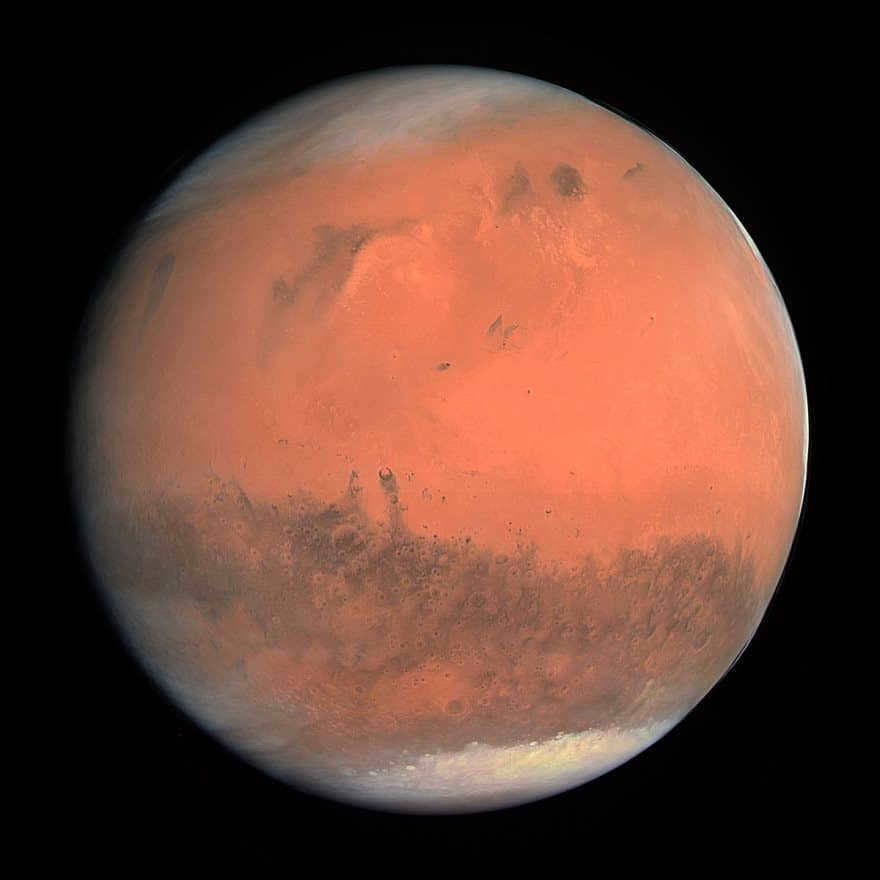
- Mars, also known as the red planet, occupies just 15% of Earth’s volume. In contrast, 2/3 of our planet is covered by water. The gravity on Mars is only 37% of Earth’s, which means that if you were to jump on Mars, you would be able to jump three times higher compared to Earth.
- One of the most notable features on Mars is Mount Olympus, which is the tallest volcano in the entire solar system. It stretches 21 kilometers in height and spans 600 kilometers in diameter. It took billions of years for Mount Olympus to form, and there are even signs of recent lava flows, suggesting that the volcano may still be active.
- Over the years, around 40 space missions have been sent to Mars, ranging from simple flybys to orbiting probes and rover landings. Some of the most recent missions include the Curiosity lander in 2012, MAVEN in 2014, India’s Mangalyan in 2014, ExoMars, and InSight, which both arrived in 2016.
- These weather catastrophes have the ability to persist for months and encompass the entire globe. The seasons become extreme due to the highly elongated elliptical orbital path. In the southern hemisphere’s closest point, a brief yet scorching summer ensues, while the northern hemisphere descends into winter. Then, their roles reverse.
- Scientists have managed to detect minute traces of the Martian atmosphere within the meteorites that have made their way to us. These meteorites drifted through space for millions of years before finally reaching us. This preliminary study of the planet aided in the preparation before the spacecraft were launched.
- Ancient Greece referred to the god of war as Ares, while the Romans adopted the name Mars for their own version. This cultural borrowing helped to associate the planet with a sense of violence. In China, for instance, Mars was known as the “fire star” due to its reddish hue, which is caused by iron oxide.
- Scientists strongly believe that Mars had water in the form of ice deposits for a significant period of time. The initial evidence of this comes from dark streaks or spots on crater walls and rocks. Given the conditions on Mars, any liquid water would need to be salty in order to prevent freezing and evaporation.
- In the next 20-40 million years, the moon Phobos will approach Mars dangerously close and eventually be torn apart by the planet’s gravity. The resulting fragments will then form a ring around Mars that could last for hundreds of millions of years.
Dimensions, Weight, and Path of the Planet Mars
The planet Mars has an equatorial radius of 3396 km and a polar radius of 3376 km (equivalent to 0.53 times the radius of Earth). In terms of size, Mars is approximately half the size of Earth. However, its mass is 6.4185 x 10 23 kg, which is only 0.151 times the mass of Earth. Despite these differences, Mars shares a similar axial tilt of 25.19° with Earth, which results in seasonal variations on the planet as well.
Physical attributes of Mars
Mars is located at a maximum distance of 249.2 million kilometers from the Sun during its aphelion, while its perihelion brings it as close as 206.7 million kilometers. This orbital pattern results in Mars completing one revolution around the Sun in approximately 1.88 years.
A skilled tarot reader will provide answers to the following inquiries:
What does the future hold for you? How will your relationships unfold? What is the optimal course of action to take?

The movement and spinning of Mars
| 2.06655⋅10 8 km. 1.381 astronomical units |
| 2.49232⋅10 8 km. 1.666 astronomical units |
| 2.2794382⋅10 8 km 1.523662 astronomical units |
The composition and surface of the planet Mars
Mars, with a density of 3.93 g/cm3, is less dense than Earth and has only 15% of our volume. As previously stated, the red color of Mars is a result of the presence of iron oxide, also known as rust. However, due to the presence of various other minerals, the planet’s surface can appear in different colors such as brown, gold, green, and more. The figure below provides a visual representation of the structure of Mars for further study.
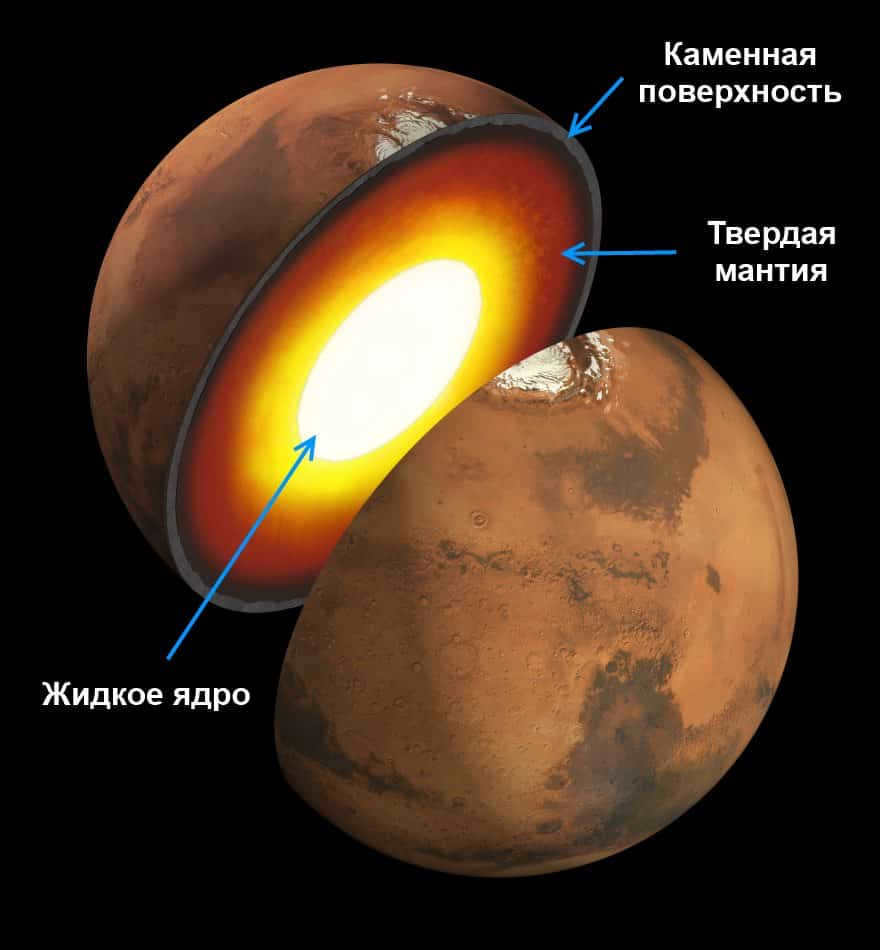
The internal composition of Mars
Mars is categorized as a terrestrial planet, indicating that it contains a substantial amount of minerals composed of oxygen, silicon, and metals. The soil has a slightly alkaline nature and contains magnesium, potassium, sodium, and chlorine.
Under these circumstances, the planet’s surface lacks water. However, a thin layer of the Martian atmosphere has preserved ice in the polar regions, which can be observed covering a significant area. Additionally, there is a theory proposing the existence of underground water in the mid-latitudes.
Mars’s structure consists of a dense metallic core surrounded by a silicate mantle. The mantle is primarily composed of iron sulfide and is twice as enriched in light elements compared to the Earth’s crust. The crust extends between 50 to 125 km in depth.
The central part of Mars, known as the core, is composed of iron, nickel, and approximately 16-17% sulfur. Due to its relatively small size and mass, the gravity on Mars is only about 37.6% of Earth’s gravity. As a result, objects on the surface of Mars will fall with an acceleration of approximately 3.711 m/s2.
It is important to mention that the Martian landscape bears a striking resemblance to a desert environment. The surface of Mars is characterized by dusty and dry conditions. The planet features various geographic formations, including mountain ranges, plains, and the largest sand dunes in the entire solar system. Additionally, Mars is home to both the tallest mountain, Olympus, and the deepest chasm, Mariner Valley.
There are numerous visible crater formations on Mars, which have been well-preserved due to the slow erosion processes on the planet. The largest crater, Hellas Planitia, spans a width of 2300 km and reaches a depth of 9 km.
Mars also showcases ravines and channels that suggest the previous existence of flowing water. Some of these channels stretch as far as 2000 kilometers in length and 100 kilometers in width.
Mars’ Satellites
Close to Mars, there are two moons called Phobos and Deimos. These moons were discovered in 1877 by Asaph Hall and were named after characters from Greek mythology. Phobos and Deimos are the sons of Ares, the god of war. The names of the moons reflect their meanings – Phobos represents fear and Deimos represents terror. The photo showcases the Martian satellites.
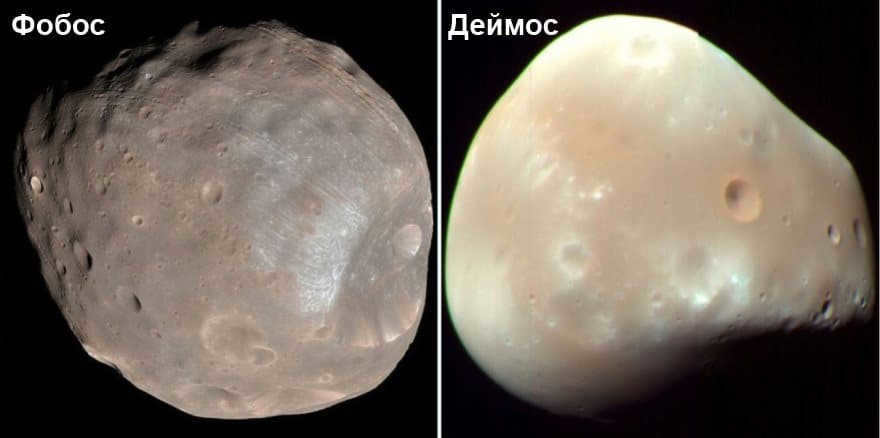

MRO captured an image of Phobos and Deimos, two small irregular satellites that may have been attracted to the planet from the asteroid belt
Phobos, with a diameter of 22 kilometers and a distance ranging from 9234.42 to 9517.58 kilometers, orbits Mars in 7 hours. This orbital time is gradually decreasing. Scientists predict that in the next 10-50 million years, Phobos will either collide with Mars or be destroyed by the planet’s gravity, forming a ring structure.
Deimos, which has a diameter of 12 km, rotates at a distance of 23455.5 – 23470.9 km. The orbital path it takes lasts for 1.26 days. Mars may also possess other moons that measure between 50-100 meters in width, and there is a possibility of a dust ring forming between two of its larger moons.
Scientists speculate that Mars’ satellites were originally ordinary asteroids that were captured by the planet’s gravitational force. However, these satellites have been observed to have circular orbits, which is unusual for captured bodies. Another hypothesis is that they could have formed from material that was ejected from Mars during its formation, but in that case, their composition would have to resemble that of the planet. It is also possible that a violent impact occurred, similar to the scenario with our Moon.
The crimson planet possesses a delicate layer of atmosphere, consisting primarily of carbon dioxide (96%), followed by traces of argon (1.93%), nitrogen (1.89%), and mixtures of oxygen with water. It is abundant in fine dust particles, measuring up to 1.5 micrometers in size. The atmospheric pressure ranges between 0.4-0.87 kPa.
A seasoned tarot reader will provide insights into inquiries such as:
What does the future hold for you? How will your relationships evolve? What is the optimal course of action?

Mars experiences a frigid climate due to its substantial distance from the Sun and its thin atmosphere. During the winter months, temperatures can plummet to as low as -143°C, while in the summer, they can rise to a relatively balmy 35°C at the poles and during midday at the equator.
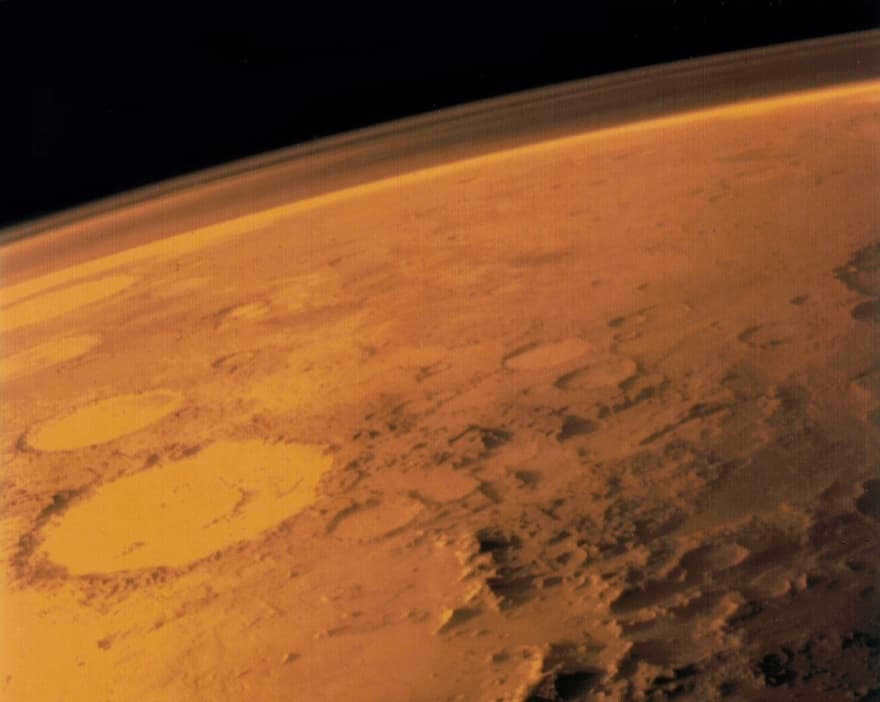

The Viking-1 lander, in 1976, captured images of the Martian atmosphere, which is thin and dusty with a red surface.
Mars is known for its active dust storms that can resemble mini-tornadoes. These storms are caused by solar heating, where warm air currents rise and create storms that can extend for thousands of kilometers.
Upon analysis, scientists also discovered traces of methane in the atmosphere, with a concentration of 30 parts per million. This suggested that methane was being released from specific areas.
Research indicates that Mars has the potential to generate approximately 270 tons of methane annually, which then ascends to the atmosphere and remains intact for a period ranging from 0.6 to 4 years before decomposing fully. The mere existence of even a minimal amount of methane implies the existence of an unidentified gas source on the planet. The lower value refers to the methane concentration on Mars.
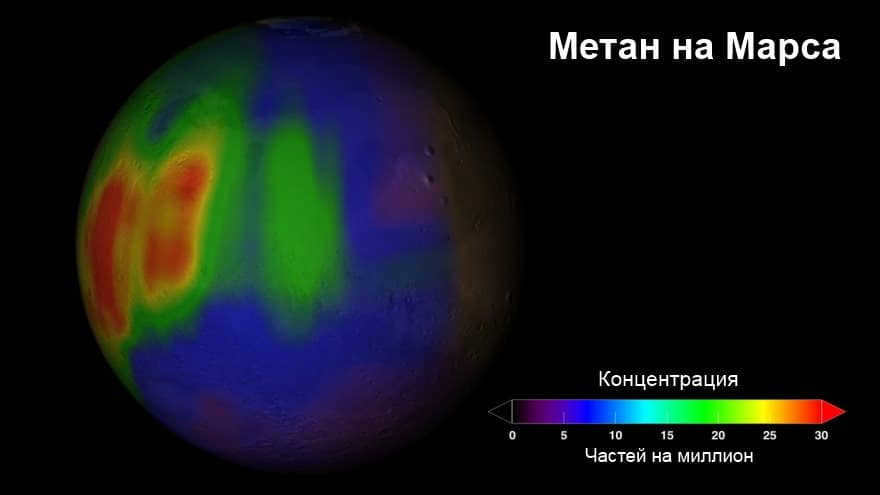
The distribution of methane in the Martian atmosphere is a subject of much speculation. Potential sources of methane on Mars include volcanic activity, comet impacts, and potential microorganisms living beneath the surface. Methane can also be produced through non-biological processes such as serpentinization, which involves water, carbon dioxide, and the mineral olivine.
In 2012, the Curiosity rover conducted several methane measurements. The initial analysis showed the presence of methane in the atmosphere, but subsequent measurements showed no detectable methane. However, in 2014, the rover detected a significant spike in methane levels, indicating a localized emission.
Satellite observations have also detected the presence of ammonia in the Martian atmosphere, although its decomposition period is much shorter. Volcanic activity is a possible source of this ammonia.
The Evolution of Mars Observation Throughout History
For centuries, humans have been captivated by the enigmatic planet Mars, which can be spotted in the night sky without the aid of telescopic instruments. The earliest known records of Mars date back to ancient Egypt in 1534 B.C., where observers were already familiar with the planet’s peculiar retrograde motion, setting it apart from other celestial bodies.
Even before the rise of the Neo-Babylonian Empire in 539 B.C., diligent astronomers meticulously documented the positions of planets, including Mars. They meticulously recorded changes in its motion, variations in brightness, and even ventured to make predictions about its future trajectory.
In the 4th century B.C., the philosopher Aristotle made a groundbreaking observation. He noticed that Mars would occasionally disappear behind the Earth’s satellite during occultation events, suggesting that the red planet was significantly farther away from us than the Moon.
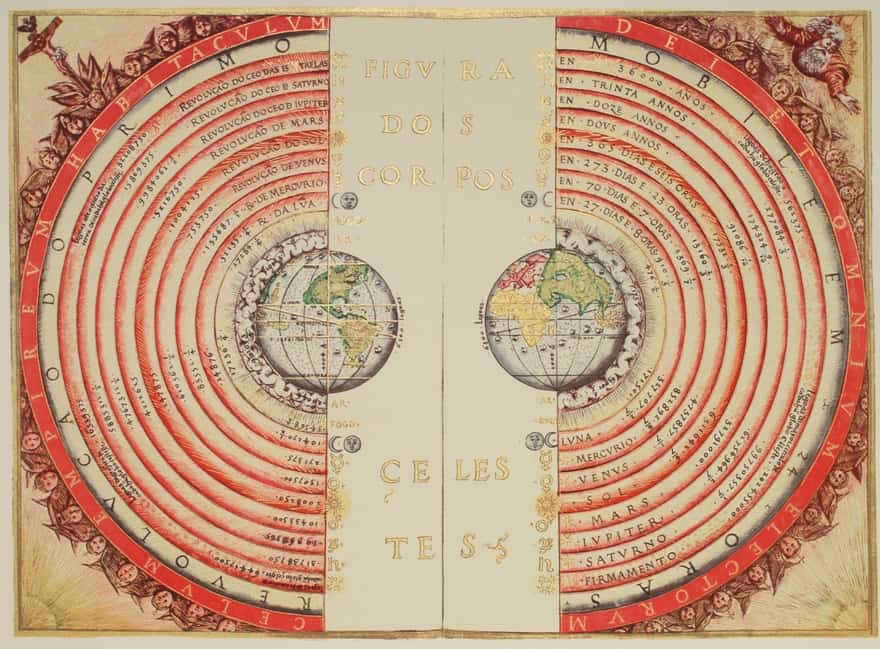

Ptolemy’s geocentric concept as depicted in 1568 by Bartolomeu Velho
Ptolemy made the decision to construct a model of the entire cosmos in order to comprehend the movement of planets. He put forward the hypothesis that there were planetary spheres responsible for retrograde motion. It is documented that the ancient Chinese were also aware of the existence of the planet in the 4th century B.C. The diameter was calculated by Indian explorers in the 5th century B.C.
Ptolemy’s geocentric model presented numerous challenges, but it continued to be the prevailing one until the 16th century when Copernicus introduced his heliocentric system, placing the Sun at the center. Galileo Galilei’s discoveries with his new telescope further supported Copernicus’s ideas. These advancements played a crucial role in determining the daily parallax of Mars and its distance.
In 1672, Giovanni Cassini conducted the initial measurements, although his equipment was limited. In the 17th century, Tycho Brahe utilized parallax, which was subsequently refined by Johannes Kepler. Christiaan Huygens then produced the first map of Mars.
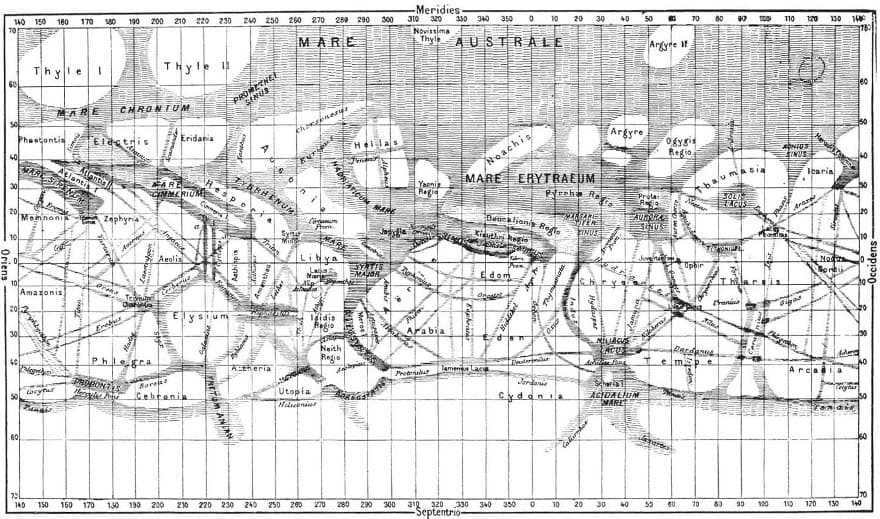

Schiaparelli’s map of Mars from 1877 depicts the presence of canals on the planet’s surface.
During the 19th century, advancements in instrument resolution allowed for the observation of Martian features. As a result, Giovanni Schiaparelli was able to create the first detailed map of Mars in 1877. This map notably included the depiction of canals, which were later understood to be an optical illusion.
Schiaparelli’s map served as inspiration for Percival Lowell, who went on to construct an observatory equipped with two powerful telescopes (30 cm and 45 cm). Lowell extensively wrote about Mars, exploring topics such as the canals and seasonal changes, such as the shrinking polar caps, which sparked speculation about the existence of Martians. Even in the 1960s, studies continued to be published on this subject.
Exploration of Mars: A Journey into the Unknown
The exploration of the planet Mars has taken great leaps forward with the advent of space exploration and the deployment of spacecraft to other celestial bodies within our solar system. The end of the 20th century marked the beginning of a new era, as space probes were launched towards the red planet. These innovative missions have allowed us to delve into the mysteries of this alien world and expand our knowledge of the planets beyond our own. While the quest for signs of Martian life remains elusive, the possibility of past existence cannot be dismissed.
Engage with a seasoned tarot reader to unlock the secrets of your future:
What does destiny hold for you? How will your relationships evolve? What choices should you make?

The exploration of the planet started in the 1960s and was actively pursued. The Soviet Union launched 9 unmanned spacecraft in an attempt to reach Mars, but they were unsuccessful. In 1964, NASA took over the mission and sent Mariner 3 and 4. Unfortunately, Mariner 3 failed, but Mariner 4 successfully arrived at the planet after 7 months.
Mariner 4 was able to capture the first high-resolution images of the alien world and transmitted valuable data about the atmospheric pressure, absence of a magnetic field, and the radiation belt. In 1969, Mariner 6 and 7 also reached Mars and contributed further to our understanding of the planet.
In 1970, a new competition arose between the United States and the Soviet Union: a race to see who could successfully place a satellite into orbit around Mars. The Soviet Union utilized three vehicles in their efforts: Cosmos-419, Mars-2, and Mars-3. Unfortunately, Cosmos-419 experienced a failure during launch and was unable to complete its mission. However, both Mars-2 and Mars-3 were successfully launched in 1971, with the journey taking a total of 7 months. Tragically, Mars-2 crashed upon landing, but Mars-3 was able to softly touch down on the Martian surface, becoming the first satellite to do so. Regrettably, the transmission from Mars-3 only lasted for a brief period of 14.5 seconds.
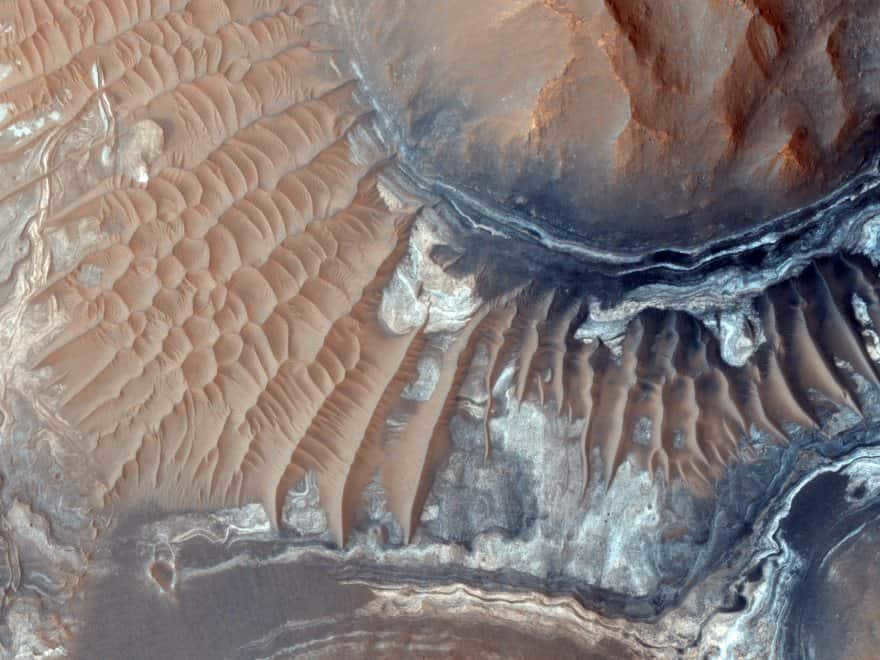
Mariner 9’s exploration of the Maze of Night in the Mariner Valley
In 1971, the United States launched Mariner 8 and Mariner 9 spacecraft. Unfortunately, Mariner 8 ended up sinking into the Atlantic Ocean, but Mariner 9 successfully entered orbit around Mars. During its mission, Mariner 9, along with Mars 2 and 3, encountered a period of intense Martian storm. Once the storm subsided, Mariner 9 captured a series of images that hinted at the possible presence of liquid water on Mars in the past.
In 1973, the USSR launched four more landers towards Mars. Unfortunately, only Mars-7 failed to deliver valuable data. However, Mars-5 proved to be the most informative, transmitting a total of 60 images back to Earth. The United States’ Viking mission, consisting of two orbiters and two landers, was launched in 1975. Its primary objectives were to collect biosignals and study the seismic, meteorological, and magnetic properties of Mars.
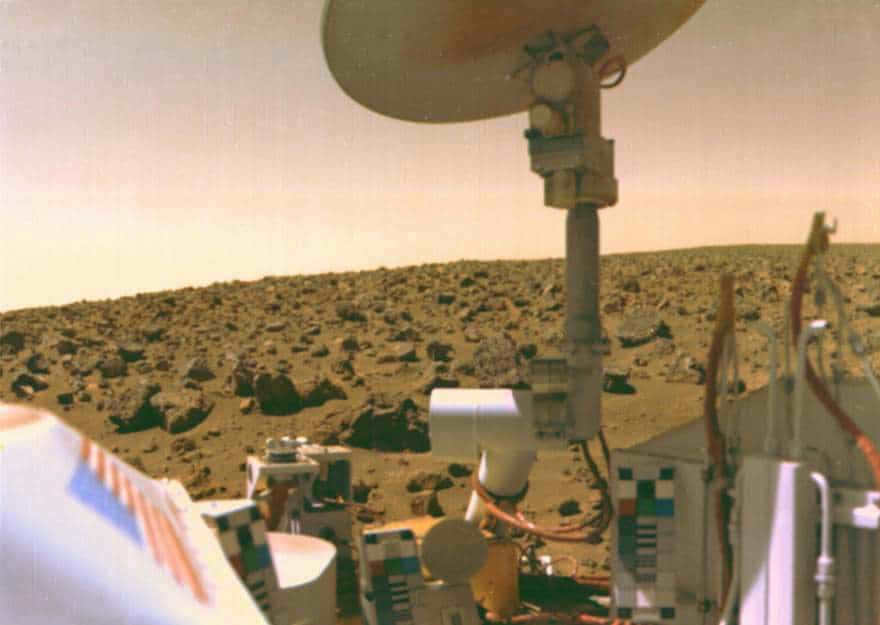

The landing of Viking 2 provided us with a captivating image of Mars.
Upon reviewing the Viking mission, it has been revealed that Mars once had water. The presence of massive floods on the planet has contributed to the formation of deep valleys and erosion of rock depressions. For a long time, Mars remained a perplexing mystery until the 1990s when the Mars Pathfinder mission was launched. This mission, which consisted of a spacecraft and a probe, successfully landed on Mars in 1987 and conducted extensive tests on various technologies.
In 1999, the Mars Global Surveyor successfully reached its destination and established a Mars tracking system in an orbit that was close to being polar. Over the course of nearly two years, it diligently examined and analyzed the Martian surface, yielding valuable insights and data. Notably, it was able to capture detailed imagery of gullies and debris streams. Additionally, its sensors detected an interesting phenomenon – the magnetic field of Mars was found to be partially present in certain areas of the crust rather than solely being generated within the planet’s core. One of the notable achievements of the Mars Global Surveyor was the creation of the first-ever three-dimensional views of the polar ice cap. Unfortunately, in 2006, communication with the spacecraft was lost, marking the end of its mission.
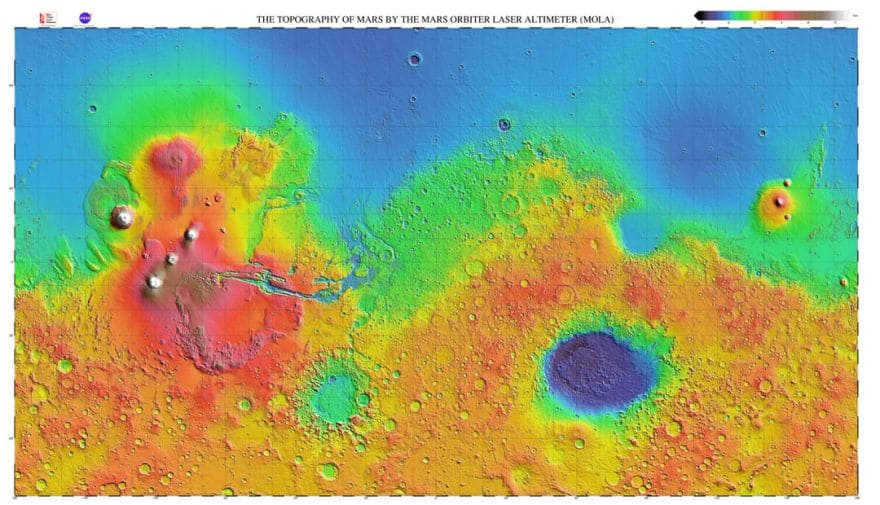

The north polar basin, with its elliptical shape partially obscured by volcanic eruptions (shown in red)
Mars Odyssey arrived in 2001 with the mission of using spectrometers to identify signs of life. In 2002, significant amounts of hydrogen were discovered. The Mars Express arrived in 2003, equipped with a probe that confirmed the presence of water and carbon dioxide ice at the south pole.
In 2003, the renowned Spirit and Opportunity rovers landed and conducted studies on the rocks and soil. The Mars Reconnaissance Orbiter (MRO) successfully reached orbit in 2006, equipped with instruments specifically designed to search for water, ice, and minerals on or beneath the planet’s surface.
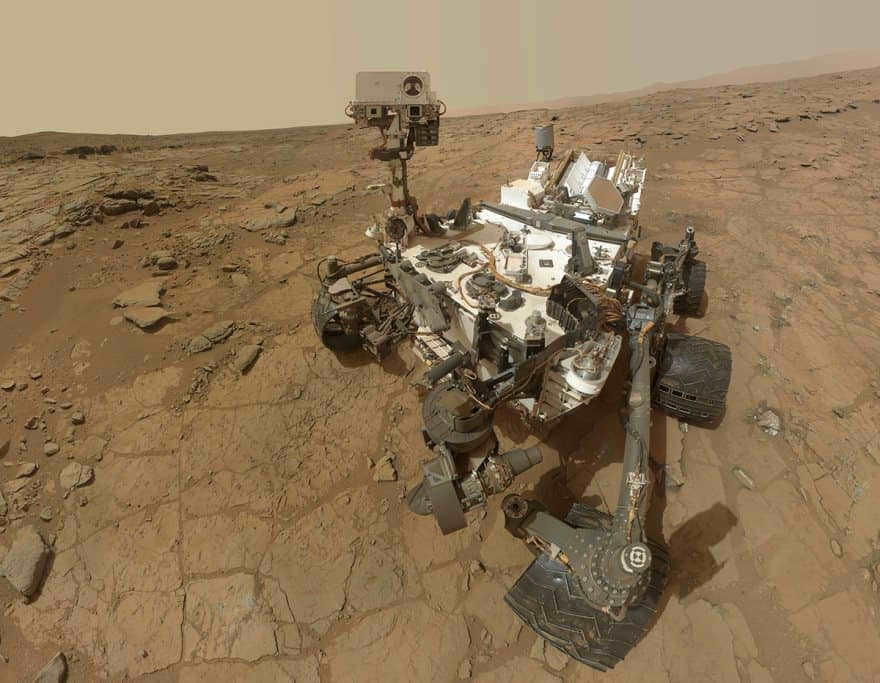
A composite portrait of Curiosity in 2013
The Martian weather and surface features are surveyed daily by MRO in order to identify the most suitable landing sites. The landing of the Curiosity rover took place at Gale Crater in 2012. Its instruments play a crucial role in uncovering the planet’s history. MAVEN began its exploration of the atmosphere in 2014, while Mangalyan, from India’s ISRO, arrived in the same year.
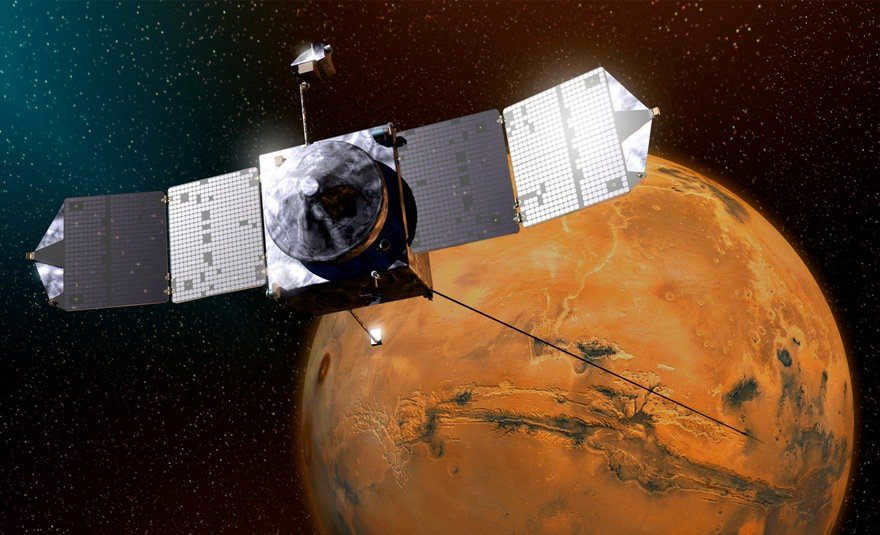
MAVEN’s arrival was portrayed in an artistic manner.
Starting from 2016, a thorough investigation into the internal structure and early geological development has commenced. Roscosmos has plans to dispatch its own spacecraft in 2018, while the United Arab Emirates will join in 2020.
Both public and private space organizations are committed to establishing manned missions in the future. NASA anticipates that the first humans will set foot on Mars by the 2030s.
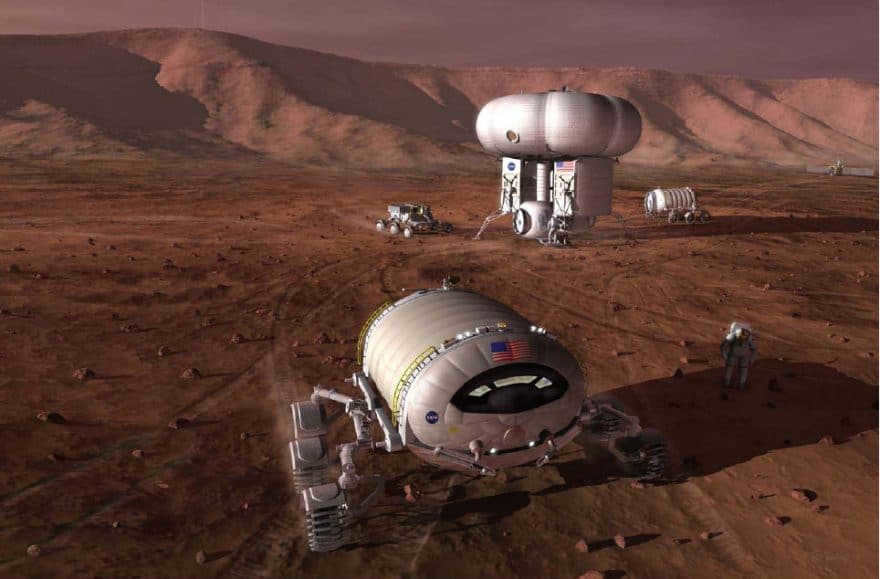

NASA’s mission concept for exploring Mars
In 2010, Barack Obama emphasized the importance of prioritizing Mars as a target for exploration. The European Space Agency (ESA) has plans to send humans to Mars between 2030 and 2035. Additionally, there are several non-profit organizations that have ambitious plans to send small crews of up to four people to Mars. These organizations are receiving funding from sponsors who envision the journey as a captivating live show.
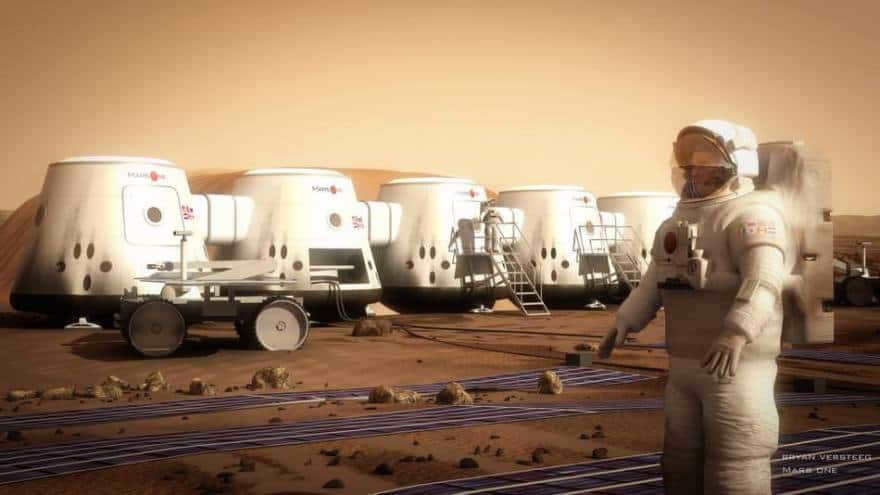
Artistic representation of a space explorer from Mars
The CEO of SpaceX, Ilon Musk, has initiated a global endeavor. He has already achieved a remarkable milestone – a reusable launch system that offers time and cost savings. The inaugural mission to Mars is slated for 2022. The prospect of colonization is already being discussed.
Mars is widely regarded as the most extensively examined extraterrestrial planet within our solar system. Ongoing missions involving rovers and probes persistently investigate its unique attributes, continually unveiling fresh insights. Scientific analysis has verified the striking similarities between Earth and the Red Planet, encompassing polar ice caps, seasonal fluctuations, atmospheric strata, and the existence of liquid water. Moreover, compelling evidence has emerged suggesting the potential existence of past life on Mars. Consequently, this alluring celestial body remains an enduring focal point for future exploration and is widely anticipated to be the initial target for human colonization.
Scientists are retaining optimism about the possibility of discovering life on Mars, even if it consists of only basic remnants rather than active organisms. Thanks to the advancements in telescopes and spacecraft, we are constantly provided with the opportunity to marvel at Mars through online platforms. On this particular website, you will discover a wealth of valuable information, stunning high-resolution photographs of Mars, and intriguing facts pertaining to the planet. Additionally, you can utilize a three-dimensional model of the solar system to monitor the visual appearance, characteristics, and orbital movements of all known celestial bodies, including the captivating Red Planet. Directly below is a comprehensive map showcasing the intricate details of Mars.
Surface map of the planet Mars
